
Treasures of Rome and Tuscany: A 10-Day Journey
 10 Day Tour of Rome and Florence
10 Day Tour of Rome and Florence
Overview
Trip Map
Itinerary
Inclusions
Reviews







10 Days 9 Nights
Best Time: Jan-Dec
Local Cuisine & Wine
Exploring Scenic Countryside
This 10-day adventure takes you to the very heart of Italy, exploring the rich history and breathtaking beauty of Rome, Florence, and the Tuscan countryside. Start your journey in Rome, where private guided tours reveal the secrets of ancient ruins and Renaissance wonders. Stroll charming medieval streets, and visit iconic landmarks like the Colosseum and Vatican City. Next, travel by train to the enchanting region of Tuscany, where picturesque hill towns, world-renowned wineries, and the artistic masterpieces of Florence await. Enjoy detailed travel guidance throughout your trip via our Go Real Travel mobile app.
- See Rome’s ancient ruins on a private guided tour, visiting the Colosseum and Roman Forum.
- Discover medieval charm in San Gimignano and enjoy a Tuscan winery lunch at a stunning vineyard.
- Marvel at Michelangelo’s David and the masterpieces of the Uffizi Gallery in Florence.
- Tour the impressive Villa d’Este and Hadrian’s Villa on a relaxing day trip to Tivoli.
- Experience the culture of Florence, from Renaissance villas to concerts in historic settings.
This 10-day adventure takes you to the very heart of Italy, exploring the rich history and breathtaking beauty of Rome, Florence, and the Tuscan countryside. Start your journey in Rome, where private guided tours reveal the secrets of ancient ruins and Renaissance wonders. Stroll charming medieval streets, and visit iconic landmarks like the Colosseum and Vatican City. Next, travel by train to the enchanting region of Tuscany, where picturesque hill towns, world-renowned wineries, and the artistic masterpieces of Florence await. Enjoy detailed travel guidance throughout your trip via our Go Real Travel mobile app.
- See Rome’s ancient ruins on a private guided tour, visiting the Colosseum and Roman Forum.
- Discover medieval charm in San Gimignano and enjoy a Tuscan winery lunch at a stunning vineyard.
- Marvel at Michelangelo’s David and the masterpieces of the Uffizi Gallery in Florence.
- Tour the impressive Villa d’Este and Hadrian’s Villa on a relaxing day trip to Tivoli.
- Experience the culture of Florence, from Renaissance villas to concerts in historic settings.

Colosseum
Historic Landmarks

Vatican City
Churches & Monasteries

Roman Forum & Palatine Hill
Historic Landmarks

Trevi Fountain
Historic Landmarks

Piazza del Duomo
Churches & Monasteries

Uffizi Gallery
Museums & Galleries

Ponte Vecchio
Architecture

Galleria dell'Accademia
Museums & Galleries

Oltrarno & Piazzale Michelangelo
Cultural
Must see sights

Colosseum
Historic Landmarks

Vatican City
Churches & Monasteries

Roman Forum & Palatine Hill
Historic Landmarks

Trevi Fountain
Historic Landmarks

Piazza del Duomo
Churches & Monasteries

Uffizi Gallery
Museums & Galleries

Ponte Vecchio
Architecture

Galleria dell'Accademia
Museums & Galleries

Oltrarno & Piazzale Michelangelo
Cultural
Starting from
$2199
per person
 Not included
Not included Secure Your Customizable Trip
Enter your details to embark on a journey that can be tailored just for you.
Start
Travelers
Add Room
Remove Room
Preferred Hotel Stars
Craft Your Own Itinerary
Select your interests and destinations for a trip plan inspired by you.
Trip Map & Itinerary
Enable/Disable Map Scrolling
Click To Make Map Interactive

Trip Timeline
 Edit Details
Edit DetailsArrival
5 nights
Rome
Italy
Train: 2h
4 nights
Florence
Italy
Departure
Day-By-Day Itinerary
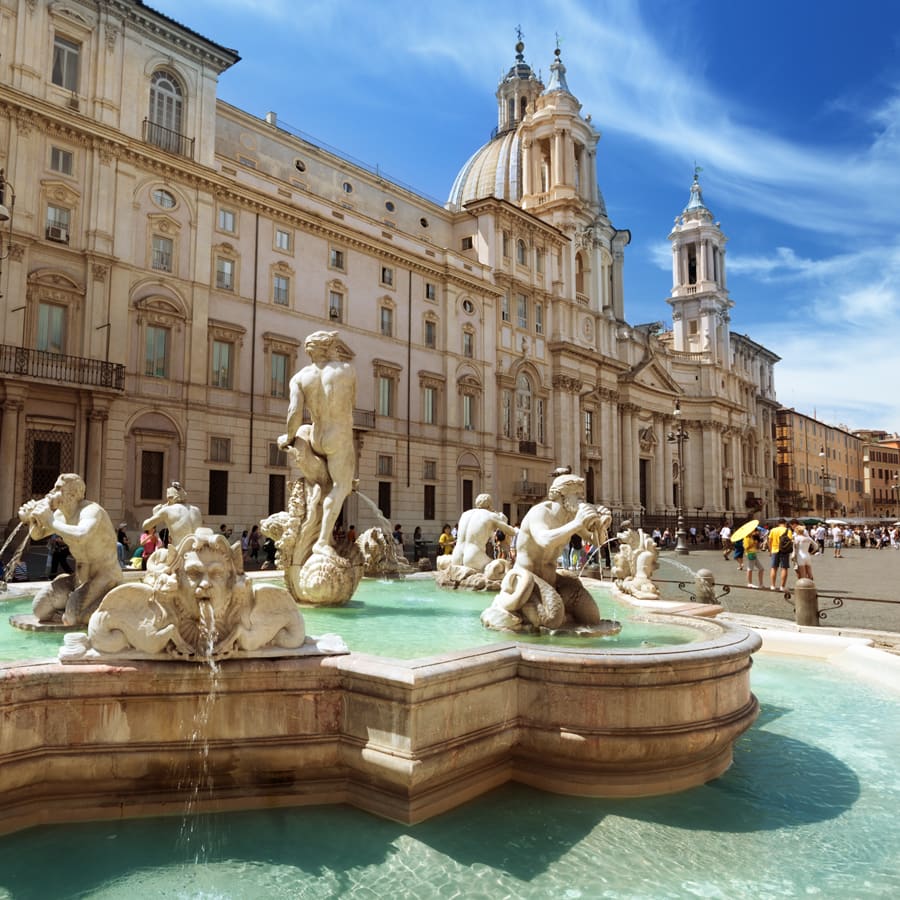
Day 1
Arrive Rome
View More
Day 1
Arrive Rome



11:30 AM
Private Transfer from Rome Fiumicino to Hotel
For your arrival in Rome, we will provide information on the customs and passport procedures. We will schedule a pick up for your flight's arrival time. You will be met at arrivals inside the terminal by a driver holding a sign with your name on it. The transfer is for your party only - you will not be sharing a vehicle. The cost of the ride will be included in your itinerary package and you will be taken directly to your hotel. IMPORTANT NOTE: Please be aware the car service can fit up to 1 checked item of luggage and 1 personal item per person, such as a purse or small backpack. If you think you will have more baggage, please inform your travel consultant as this may result in an additional fee.

Day 1
Arrive Rome
View More


Day 1
Arrive Rome




11:30 AM:
Private Transfer to your Hotel
Mid-Day/Afternoon:
Rome's Historic Center
Late Afternoon/Early Evening:
Spanish Steps


Day 2
Rome
View More
Day 2
Rome



9:00 AM - 12:00 PM
Heart of the Empire - Private Tour of Ancient Rome & the Colosseum
On this 3-hour private guided tour, you will explore the imposing remains of ancient Rome. Your guide will explain the extraordinary history of the birth of Rome, life in the city and everything about the fall of the Empire. Visit the Colosseum, the monumental ruins of the Roman Forum, and end the tour on the Capitoline Hill, the smallest and most important of the seven hills of Ancient Rome.

Colosseum
Ancient Roman Ampitheater
Show More

Colosseum
Ancient Roman Ampitheater
Show More

Colosseum
Ancient Roman Ampitheater
Show More

Colosseum
Ancient Roman Ampitheater
Show More

Colosseum
Ancient Roman Ampitheater
Show More
prev
next

Day 2
Rome
View More

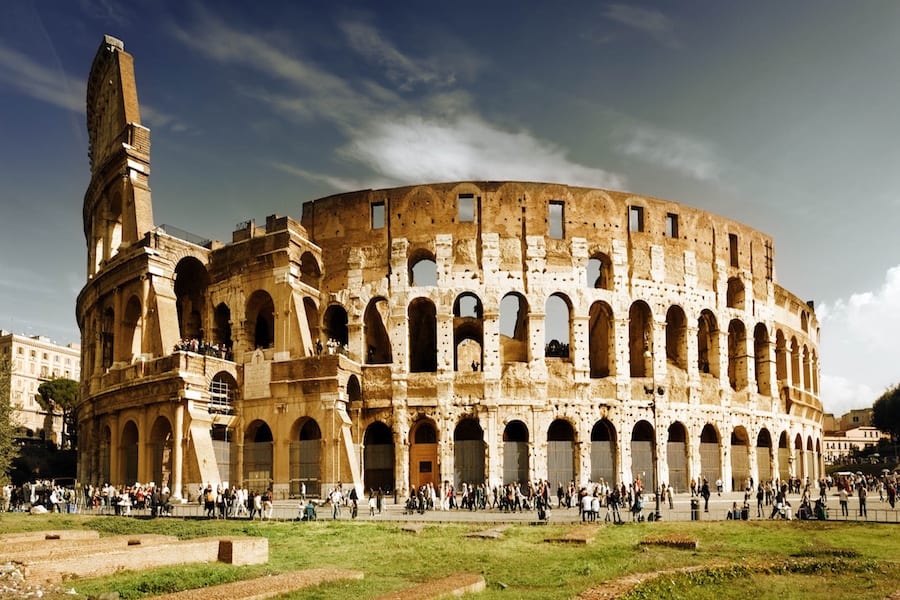
Colosseum
 Highlight of Ancient Rome Guided Walk
Highlight of Ancient Rome Guided WalkAncient Roman Ampitheater
Monumental Roman amphitheater once used for gladiatorial games

Colosseum
 Highlight of Ancient Rome Guided Walk
Highlight of Ancient Rome Guided WalkAncient Roman Ampitheater
Monumental Roman amphitheater once used for gladiatorial games

Colosseum
 Highlight of Ancient Rome Guided Walk
Highlight of Ancient Rome Guided WalkAncient Roman Ampitheater
Monumental Roman amphitheater once used for gladiatorial games

Colosseum
 Highlight of Ancient Rome Guided Walk
Highlight of Ancient Rome Guided WalkAncient Roman Ampitheater
Monumental Roman amphitheater once used for gladiatorial games

Colosseum
 Highlight of Ancient Rome Guided Walk
Highlight of Ancient Rome Guided WalkAncient Roman Ampitheater
Monumental Roman amphitheater once used for gladiatorial games
prev
next


Day 3
Rome
View More
Day 3
Rome


Early Morning to Late Afternoon
Explore the Vatican City's Many Wonders
Rome is unique in the world in that it contains an independent country within its city limits - the Vatican City, from where the Pope administers the Catholic Church. The symbolic center of Catholicism is St Peter's Basilica, the second-largest Catholic church in the world and among the most beautiful. The Vatican Museum contains one of the greatest collections of art in existence, including Michelangelo's jaw-dropping Sistine Chapel. The popes had a bigger influence on Rome than just the collection of art. The Pope's title is actually Bishop of Rome, and popes administed the city for centuries, shaping its architecture & public spaces. Rome was re-built to be an example of urban beauty, and the Vatican was meant to be the showcase within the showcase. Their success is evident from the throngs of visitors who flock here even today.

Vatican Museums
Book early if you want to see the Vatican Museum's monumental works of art from the greatest Italian artists of the Renaissance.
Show More

St Peter’s Basilica
Explore the gigantic and incredibly beautiful church known as "the greatest of all churches of Christendom".
Show More

Vatican Gardens
Escape the crowds in this oasis of green hidden behind the walls of the Vatican.
Show More

St Peter's Square
Stand in the middle of this famous square in which the faithful gather to hear the Pope give audiences and celebrate mass.
Show More

Sistine Chapel
Gaze up at the world's most famous ceiling, the masterpiece of Michelangelo.
Show More

Vatican Museums
Book early if you want to see the Vatican Museum's monumental works of art from the greatest Italian artists of the Renaissance.
Show More

St Peter’s Basilica
Explore the gigantic and incredibly beautiful church known as "the greatest of all churches of Christendom".
Show More

Vatican Gardens
Escape the crowds in this oasis of green hidden behind the walls of the Vatican.
Show More

St Peter's Square
Stand in the middle of this famous square in which the faithful gather to hear the Pope give audiences and celebrate mass.
Show More

Sistine Chapel
Gaze up at the world's most famous ceiling, the masterpiece of Michelangelo.
Show More

Vatican Museums
Book early if you want to see the Vatican Museum's monumental works of art from the greatest Italian artists of the Renaissance.
Show More
prev
next

Day 3
Rome
View More


Vatican Museums
 Highlight of Vatican City
Highlight of Vatican CityBook early if you want to see the Vatican Museum's monumental works of art from the greatest Italian artists of the Renaissance.
The Vatican Museum is actually 26 different museums, which include not only exhibitions but chapels, apartments, and other rooms of the Vatican palace, covering a huge range of fine and applied arts patronized by the popes. There's also an outstanding collection of ancient antiquities (including even the Emperor Nero's red stone bathtub), a gallery of hand-painted maps, and whole rooms turned into works of art. In addition to ancient and medieval works of art, you'll see masterpieces by the "who's who" of the Italian Renaissance, including Raphael, Leonardo da Vinci, Titian, and Caravaggio. Other highlights include panels by the brilliant monk-artist Fra Angelico, works from the Venetian school, including Vavarini, and much, much more. Booking in advance is highly recommended as otherwise you can wait for hours or not even be able to get in at all.
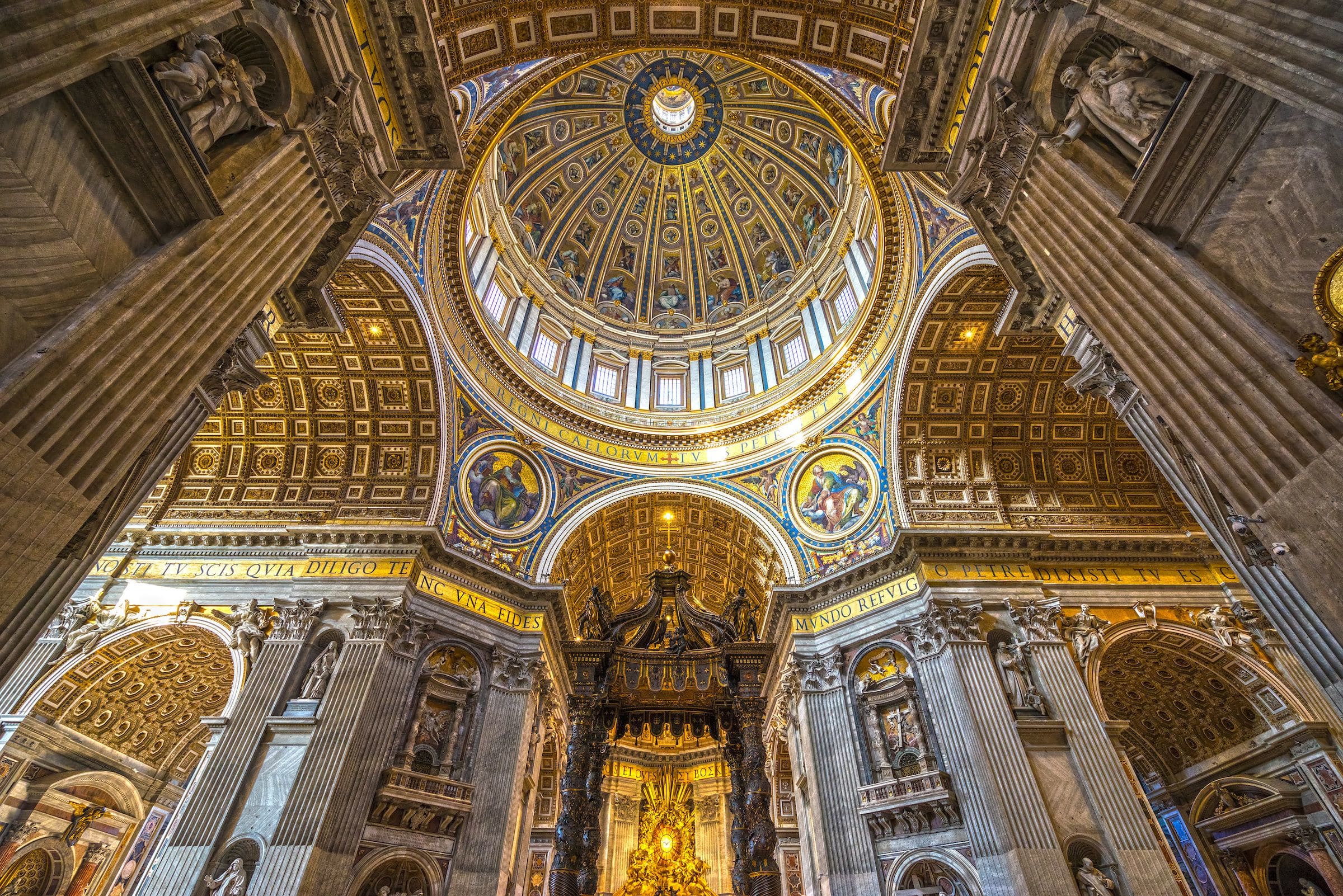
St Peter’s Basilica
 Highlight of Vatican City
Highlight of Vatican CityExplore the gigantic and incredibly beautiful church known as "the greatest of all churches of Christendom".
The basilica is one of the chief pilgrimage sites in the Christian world, and one of the most popular tourist destinations in Rome. The basilica is the symbolic center of the church not only because the Pope frequently celebrates Mass there, but because it is believed that the apostle St. Peter is buried beneath it. Catholics consider Peter as the first Bishop of Rome and "the rock" upon which the Catholic Church was built, in accordance with Christ's instructions. Inside you can admire sculptures by Bernini as well as Michelangelo's famous sculpture of the Virgin Mary holding the crucified Jesus, known as The Pietà. The church's elaborate and impressive golden interior is a sight to behold. Other sights include St Peter's tomb, the Papal crypts in the necropolis under the basilica, as well as the dome, which rewards visitors with views over Rome. Entry is free, but queues to visit the Basilica can be lengthy, so it is highly advised to either get there early or to purchase a skip the line entrance. The dome is also paid entry.

Vatican Gardens
 Highlight of Vatican City
Highlight of Vatican CityEscape the crowds in this oasis of green hidden behind the walls of the Vatican.
Accessible only via a guided tour, the gardens are definitely worth a visit. Just as the Popes have for hundreds of years, you can stroll the gardens and relax amidst the greenery, while taking in the perfect view of St. Peter's.
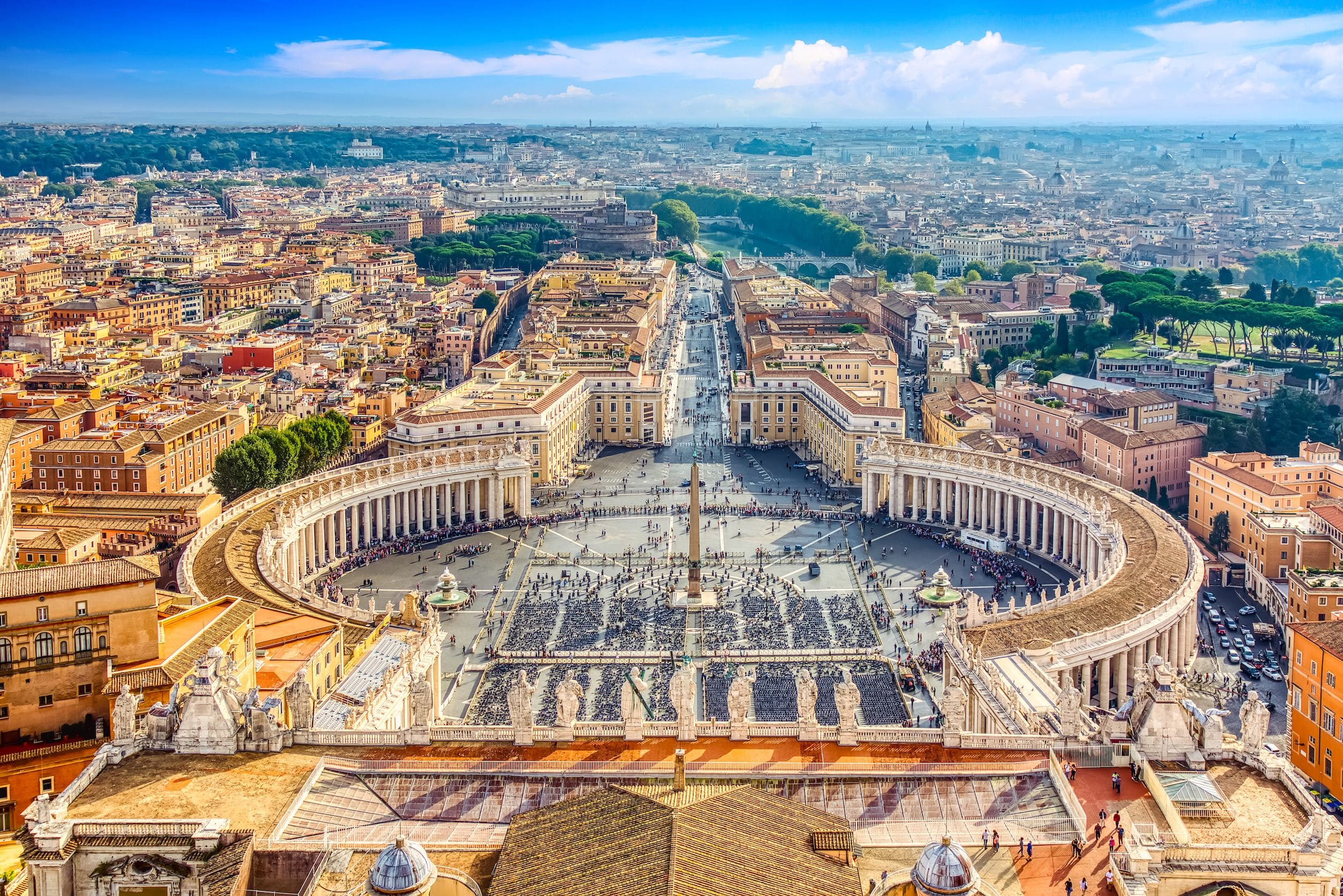
St Peter's Square
 Highlight of Vatican City
Highlight of Vatican CityStand in the middle of this famous square in which the faithful gather to hear the Pope give audiences and celebrate mass.
As one of the most superb conceptions of its kind in civic architecture, St Peter’s Square is the masterpiece of Gian Lorenzo Bernini and makes a wonderful approach to one of the world’s most magnificent churches, St Peter's Basilica. An oval rather than an actual square, the piazza, laid out in 1656-67, is partially enclosed by two semi-circular colonnades on which stand 96 statues of saints and martyrs. At the center of the oval stands an 84-foot (26m) tall Egyptian obelisk of red granite.

Sistine Chapel
 Highlight of Vatican City
Highlight of Vatican CityGaze up at the world's most famous ceiling, the masterpiece of Michelangelo.
This famous chapel inside the Vatican Museums is best known for Michelangelo's 16th-century painted ceiling of "The Creation of Adam" and "The Last Judgement" fresco that covers the whole altar wall of the chapel. The jaw-dropping sight is not to be missed, considered one of the top highlights of visiting the Vatican Museums and one of the top artistic wonders of the world.

Vatican Museums
 Highlight of Vatican City
Highlight of Vatican CityBook early if you want to see the Vatican Museum's monumental works of art from the greatest Italian artists of the Renaissance.
The Vatican Museum is actually 26 different museums, which include not only exhibitions but chapels, apartments, and other rooms of the Vatican palace, covering a huge range of fine and applied arts patronized by the popes. There's also an outstanding collection of ancient antiquities (including even the Emperor Nero's red stone bathtub), a gallery of hand-painted maps, and whole rooms turned into works of art. In addition to ancient and medieval works of art, you'll see masterpieces by the "who's who" of the Italian Renaissance, including Raphael, Leonardo da Vinci, Titian, and Caravaggio. Other highlights include panels by the brilliant monk-artist Fra Angelico, works from the Venetian school, including Vavarini, and much, much more. Booking in advance is highly recommended as otherwise you can wait for hours or not even be able to get in at all.

St Peter’s Basilica
 Highlight of Vatican City
Highlight of Vatican CityExplore the gigantic and incredibly beautiful church known as "the greatest of all churches of Christendom".
The basilica is one of the chief pilgrimage sites in the Christian world, and one of the most popular tourist destinations in Rome. The basilica is the symbolic center of the church not only because the Pope frequently celebrates Mass there, but because it is believed that the apostle St. Peter is buried beneath it. Catholics consider Peter as the first Bishop of Rome and "the rock" upon which the Catholic Church was built, in accordance with Christ's instructions. Inside you can admire sculptures by Bernini as well as Michelangelo's famous sculpture of the Virgin Mary holding the crucified Jesus, known as The Pietà. The church's elaborate and impressive golden interior is a sight to behold. Other sights include St Peter's tomb, the Papal crypts in the necropolis under the basilica, as well as the dome, which rewards visitors with views over Rome. Entry is free, but queues to visit the Basilica can be lengthy, so it is highly advised to either get there early or to purchase a skip the line entrance. The dome is also paid entry.

Vatican Gardens
 Highlight of Vatican City
Highlight of Vatican CityEscape the crowds in this oasis of green hidden behind the walls of the Vatican.
Accessible only via a guided tour, the gardens are definitely worth a visit. Just as the Popes have for hundreds of years, you can stroll the gardens and relax amidst the greenery, while taking in the perfect view of St. Peter's.

St Peter's Square
 Highlight of Vatican City
Highlight of Vatican CityStand in the middle of this famous square in which the faithful gather to hear the Pope give audiences and celebrate mass.
As one of the most superb conceptions of its kind in civic architecture, St Peter’s Square is the masterpiece of Gian Lorenzo Bernini and makes a wonderful approach to one of the world’s most magnificent churches, St Peter's Basilica. An oval rather than an actual square, the piazza, laid out in 1656-67, is partially enclosed by two semi-circular colonnades on which stand 96 statues of saints and martyrs. At the center of the oval stands an 84-foot (26m) tall Egyptian obelisk of red granite.

Sistine Chapel
 Highlight of Vatican City
Highlight of Vatican CityGaze up at the world's most famous ceiling, the masterpiece of Michelangelo.
This famous chapel inside the Vatican Museums is best known for Michelangelo's 16th-century painted ceiling of "The Creation of Adam" and "The Last Judgement" fresco that covers the whole altar wall of the chapel. The jaw-dropping sight is not to be missed, considered one of the top highlights of visiting the Vatican Museums and one of the top artistic wonders of the world.

Vatican Museums
 Highlight of Vatican City
Highlight of Vatican CityBook early if you want to see the Vatican Museum's monumental works of art from the greatest Italian artists of the Renaissance.
The Vatican Museum is actually 26 different museums, which include not only exhibitions but chapels, apartments, and other rooms of the Vatican palace, covering a huge range of fine and applied arts patronized by the popes. There's also an outstanding collection of ancient antiquities (including even the Emperor Nero's red stone bathtub), a gallery of hand-painted maps, and whole rooms turned into works of art. In addition to ancient and medieval works of art, you'll see masterpieces by the "who's who" of the Italian Renaissance, including Raphael, Leonardo da Vinci, Titian, and Caravaggio. Other highlights include panels by the brilliant monk-artist Fra Angelico, works from the Venetian school, including Vavarini, and much, much more. Booking in advance is highly recommended as otherwise you can wait for hours or not even be able to get in at all.
prev
next


Day 4
Rome
View More
Day 4
Rome


Morning to Early Evening
Escape the City to Delightful Tivoli
Tivoli was a celebrated holiday resort even in ancient times, thanks to its climate and its idyllic position, with scenic cascades and an abundance of water issuing from the Aniene River. The travertine stone used at sites like the Colosseum was quarried here, meaning it was also a convenient place to build big, fancy villas. During your day trip to Tivoli, you can visit the Villa d’ Este, which is famous for its terraced hillside Italian Renaissance garden. It was conceived to appear like a mythical garden of the ancient past and is unique for its incredible profusion of magnificent fountains. The town is also famous for its villa built by and for Emperor Hadrian, Villa Adriana.

Villa d'Este
Find all the fountains and grottos in these sumptuous Renaissance gardens.
Show More

Villa Hadrian
Explore the ruins of this once luxurious retreat built for one of Rome's greatest Emperors.
Show More

Villa d'Este
Find all the fountains and grottos in these sumptuous Renaissance gardens.
Show More

Villa Hadrian
Explore the ruins of this once luxurious retreat built for one of Rome's greatest Emperors.
Show More

Villa d'Este
Find all the fountains and grottos in these sumptuous Renaissance gardens.
Show More

Villa Hadrian
Explore the ruins of this once luxurious retreat built for one of Rome's greatest Emperors.
Show More
prev
next

Day 4
Rome
View More


Villa d'Este
 Highlight of Tivoli
Highlight of TivoliFind all the fountains and grottos in these sumptuous Renaissance gardens.
Perhaps the biggest surprise for visitors to Villa d'Este is the grand gardens and fountains that surround the villa. They encompass terraces, stairways, and slopes which lead to an impressive number of fountains and grottos. While the main attraction is the garden, the palace's rooms contain some beautifully lavish frescoes on the walls and ceilings, and intricately painted and decorated reception rooms. The Villa d'Este was built in the 1550s for Cardinal Ippolito d'Este, the governor of Tivoli and the son of Lucretia Borgia, an Italian noblewoman of the House of Borgia and daughter of Pope Alexander VI. Built over a Benedictine convent, the palace was intended for entertaining, with the Cardinal looking to relive the splendors of the courts of Ferrara, Rome and Fontainebleau.

Villa Hadrian
 Highlight of Tivoli
Highlight of TivoliExplore the ruins of this once luxurious retreat built for one of Rome's greatest Emperors.
Built at the peak fo Emperor Hadrian's power, Villa Adriana was the Emperor's preferred country retreat, away from the stresses, demands and political life of Rome. His exuberant palace and surrounding buildings once spread over an area of 120 acres of countryside, consisting of a theatre, libraries, a stadium, grand water features, thermal baths, servants' quarters and underground supply tunnels. It is said the Emperor fell in love with Tivoli and his palace so much that he eventually spent his last decade living and ruling from this place. Many of the structures remain in good condition, despite being plundered of its marble, statues, mosaics, and monuments, and today's visitors can spend hours wandering among the extensive ruins.

Villa d'Este
 Highlight of Tivoli
Highlight of TivoliFind all the fountains and grottos in these sumptuous Renaissance gardens.
Perhaps the biggest surprise for visitors to Villa d'Este is the grand gardens and fountains that surround the villa. They encompass terraces, stairways, and slopes which lead to an impressive number of fountains and grottos. While the main attraction is the garden, the palace's rooms contain some beautifully lavish frescoes on the walls and ceilings, and intricately painted and decorated reception rooms. The Villa d'Este was built in the 1550s for Cardinal Ippolito d'Este, the governor of Tivoli and the son of Lucretia Borgia, an Italian noblewoman of the House of Borgia and daughter of Pope Alexander VI. Built over a Benedictine convent, the palace was intended for entertaining, with the Cardinal looking to relive the splendors of the courts of Ferrara, Rome and Fontainebleau.

Villa Hadrian
 Highlight of Tivoli
Highlight of TivoliExplore the ruins of this once luxurious retreat built for one of Rome's greatest Emperors.
Built at the peak fo Emperor Hadrian's power, Villa Adriana was the Emperor's preferred country retreat, away from the stresses, demands and political life of Rome. His exuberant palace and surrounding buildings once spread over an area of 120 acres of countryside, consisting of a theatre, libraries, a stadium, grand water features, thermal baths, servants' quarters and underground supply tunnels. It is said the Emperor fell in love with Tivoli and his palace so much that he eventually spent his last decade living and ruling from this place. Many of the structures remain in good condition, despite being plundered of its marble, statues, mosaics, and monuments, and today's visitors can spend hours wandering among the extensive ruins.

Villa d'Este
 Highlight of Tivoli
Highlight of TivoliFind all the fountains and grottos in these sumptuous Renaissance gardens.
Perhaps the biggest surprise for visitors to Villa d'Este is the grand gardens and fountains that surround the villa. They encompass terraces, stairways, and slopes which lead to an impressive number of fountains and grottos. While the main attraction is the garden, the palace's rooms contain some beautifully lavish frescoes on the walls and ceilings, and intricately painted and decorated reception rooms. The Villa d'Este was built in the 1550s for Cardinal Ippolito d'Este, the governor of Tivoli and the son of Lucretia Borgia, an Italian noblewoman of the House of Borgia and daughter of Pope Alexander VI. Built over a Benedictine convent, the palace was intended for entertaining, with the Cardinal looking to relive the splendors of the courts of Ferrara, Rome and Fontainebleau.

Villa Hadrian
 Highlight of Tivoli
Highlight of TivoliExplore the ruins of this once luxurious retreat built for one of Rome's greatest Emperors.
Built at the peak fo Emperor Hadrian's power, Villa Adriana was the Emperor's preferred country retreat, away from the stresses, demands and political life of Rome. His exuberant palace and surrounding buildings once spread over an area of 120 acres of countryside, consisting of a theatre, libraries, a stadium, grand water features, thermal baths, servants' quarters and underground supply tunnels. It is said the Emperor fell in love with Tivoli and his palace so much that he eventually spent his last decade living and ruling from this place. Many of the structures remain in good condition, despite being plundered of its marble, statues, mosaics, and monuments, and today's visitors can spend hours wandering among the extensive ruins.
prev
next


Day 5
Rome
View More
Day 5
Rome


Morning/Mid-Day
Traveling the Via Appia on Foot or Bicycle
One of the earliest and strategically most important Roman roads of the ancient republic, the Via Appia (or Appian Way) once spanned 350 miles (563km), all the way from the Roman Forum in Rome to modern-day Brindisi. On the south side of Rome lies one of the best preserved stretches of the road, the Via Apia Antica. Take an afternoon to explore the ruins, catacombs, and sights along this infamously cobbled way. Exploring on foot is a relaxed and easy way to do it, made easier by the fact that bus stops along the way mean you don't have to backtrack. Bike rentals are also available and are a good way to cover as much ground as possible. But as an ancient cobbled road, sections of this walk are very bumpy, and depending on which route you take, you may encounter traffic. So you may want to consider if biking with a guided tour makes more sense.

Catacombs of San Callisto (i.e. St. Callixtus)
Discover the crypt and catacombs of an ancient Christian burial site estimated to hold half a million bodies.
Show More

Catacombs of San Callisto (i.e. St. Callixtus)
Discover the crypt and catacombs of an ancient Christian burial site estimated to hold half a million bodies.
Show More

Catacombs of San Callisto (i.e. St. Callixtus)
Discover the crypt and catacombs of an ancient Christian burial site estimated to hold half a million bodies.
Show More

Catacombs of San Callisto (i.e. St. Callixtus)
Discover the crypt and catacombs of an ancient Christian burial site estimated to hold half a million bodies.
Show More

Catacombs of San Callisto (i.e. St. Callixtus)
Discover the crypt and catacombs of an ancient Christian burial site estimated to hold half a million bodies.
Show More
prev
next

Day 5
Rome
View More

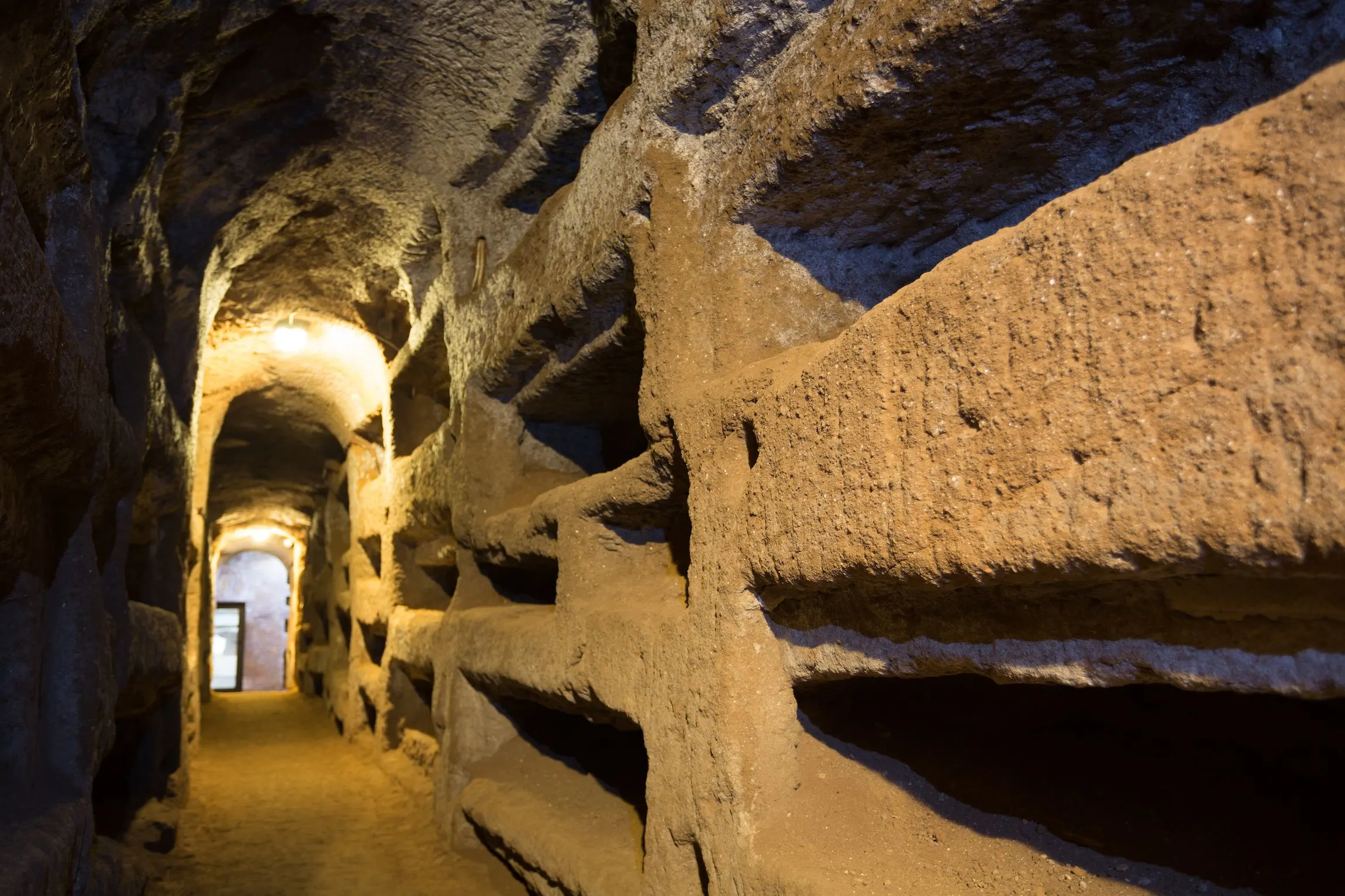
Catacombs of San Callisto (i.e. St. Callixtus)
 Highlight of Via Appia Antica
Highlight of Via Appia AnticaDiscover the crypt and catacombs of an ancient Christian burial site estimated to hold half a million bodies.
The catacombs are the most important landmark along the ancient Appian Way route because they include the Crypt of the Popes, which contained the remains of nine popes buried between the 2nd and 4th centuries. In times of persecution, the catacombs also provided a secret place of worship for early Christians. There are five levels and roughly 12 miles (20km) of passageways. Over time, the catacombs were mostly forgotten as the relics of the popes and saints they contained had been moved to different churces of Rome. It was not until the 19th century that Italian architects rediscovered it.

Catacombs of San Callisto (i.e. St. Callixtus)
 Highlight of Via Appia Antica
Highlight of Via Appia AnticaDiscover the crypt and catacombs of an ancient Christian burial site estimated to hold half a million bodies.
The catacombs are the most important landmark along the ancient Appian Way route because they include the Crypt of the Popes, which contained the remains of nine popes buried between the 2nd and 4th centuries. In times of persecution, the catacombs also provided a secret place of worship for early Christians. There are five levels and roughly 12 miles (20km) of passageways. Over time, the catacombs were mostly forgotten as the relics of the popes and saints they contained had been moved to different churces of Rome. It was not until the 19th century that Italian architects rediscovered it.

Catacombs of San Callisto (i.e. St. Callixtus)
 Highlight of Via Appia Antica
Highlight of Via Appia AnticaDiscover the crypt and catacombs of an ancient Christian burial site estimated to hold half a million bodies.
The catacombs are the most important landmark along the ancient Appian Way route because they include the Crypt of the Popes, which contained the remains of nine popes buried between the 2nd and 4th centuries. In times of persecution, the catacombs also provided a secret place of worship for early Christians. There are five levels and roughly 12 miles (20km) of passageways. Over time, the catacombs were mostly forgotten as the relics of the popes and saints they contained had been moved to different churces of Rome. It was not until the 19th century that Italian architects rediscovered it.

Catacombs of San Callisto (i.e. St. Callixtus)
 Highlight of Via Appia Antica
Highlight of Via Appia AnticaDiscover the crypt and catacombs of an ancient Christian burial site estimated to hold half a million bodies.
The catacombs are the most important landmark along the ancient Appian Way route because they include the Crypt of the Popes, which contained the remains of nine popes buried between the 2nd and 4th centuries. In times of persecution, the catacombs also provided a secret place of worship for early Christians. There are five levels and roughly 12 miles (20km) of passageways. Over time, the catacombs were mostly forgotten as the relics of the popes and saints they contained had been moved to different churces of Rome. It was not until the 19th century that Italian architects rediscovered it.

Catacombs of San Callisto (i.e. St. Callixtus)
 Highlight of Via Appia Antica
Highlight of Via Appia AnticaDiscover the crypt and catacombs of an ancient Christian burial site estimated to hold half a million bodies.
The catacombs are the most important landmark along the ancient Appian Way route because they include the Crypt of the Popes, which contained the remains of nine popes buried between the 2nd and 4th centuries. In times of persecution, the catacombs also provided a secret place of worship for early Christians. There are five levels and roughly 12 miles (20km) of passageways. Over time, the catacombs were mostly forgotten as the relics of the popes and saints they contained had been moved to different churces of Rome. It was not until the 19th century that Italian architects rediscovered it.
prev
next

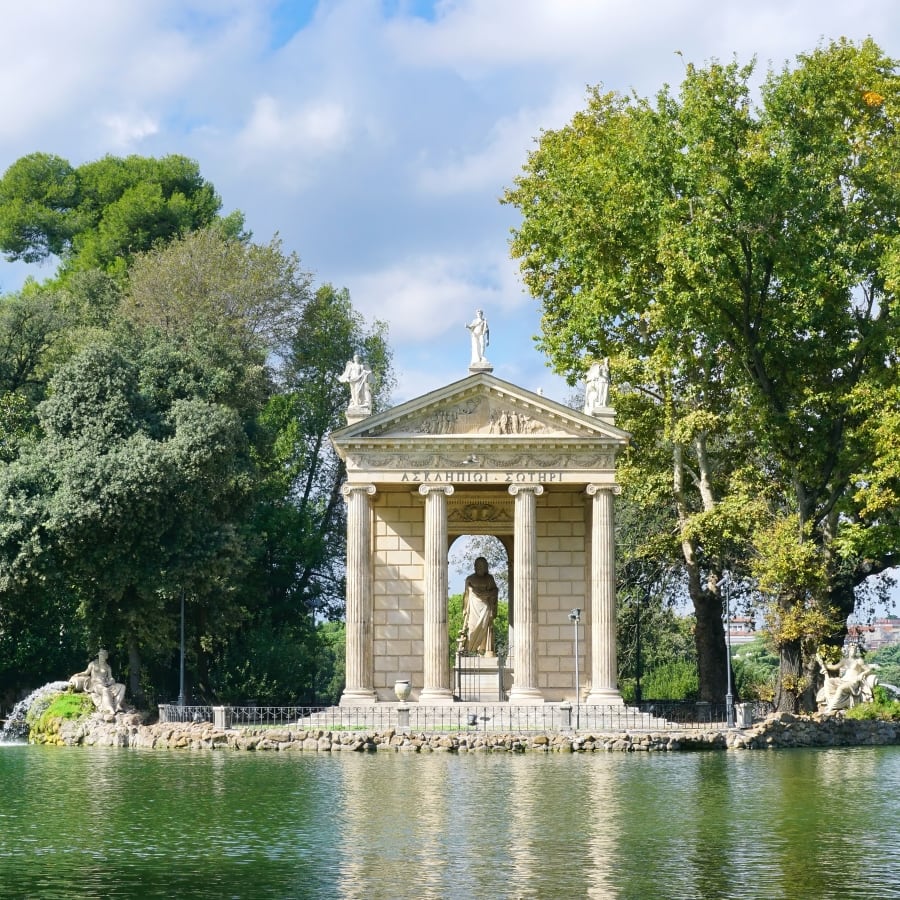
Day 6
Rome to Florence
View More
Day 6
Rome to Florence





Morning
Exploring the Villa Borghese Gardens
The Villa Borghese Park acts as the main respite and sanctuary for Romans and tourists alike away from the din of central Rome. Overlooking Piazza del Popolo and only a stone's throw from the Spanish Steps, the area was a district of market gardens, olive groves, and patrician villas until taken over as summer estates by the city's wealthy during the Renaissance. The most notable is Villa Borghese, which now houses one of the city's best non-Vatican art collections. The adjacent Pincio Gardens offer a grand vista over Rome.

Galleria Borghese
Visit Rome's most famous art gallery outside of the Vatican Museums.
Show More

National Gallery of Modern and Contemporary Art
See the most important collection in existence of Italian modern art.
Show More

Medici Villa
Take a peak at a 16th-century cardinal's villa that was once considered one of the grandest residences in the city.
Show More

Galleria Borghese
Visit Rome's most famous art gallery outside of the Vatican Museums.
Show More

National Gallery of Modern and Contemporary Art
See the most important collection in existence of Italian modern art.
Show More

Medici Villa
Take a peak at a 16th-century cardinal's villa that was once considered one of the grandest residences in the city.
Show More

Galleria Borghese
Visit Rome's most famous art gallery outside of the Vatican Museums.
Show More
prev
next

Day 6
Rome to Florence
View More


Galleria Borghese
 Highlight of Villa Borghese Gardens
Highlight of Villa Borghese GardensVisit Rome's most famous art gallery outside of the Vatican Museums.
The gallery started out as the private family collection of the powerful Borghese family, who poured much of their wealth into the patronage of the best Renaissance-era artists. It contains masterpieces not only by Bernini and Caravaggio, but also Raphael, Rubens, and Titian. Don't miss in particular Caravaggio's David with the Head of Goliath - the head is said to be a self-portrait. It's obligatory to book your visit in advance, you'll need a printable confirmation and a booking number.

National Gallery of Modern and Contemporary Art
 Highlight of Villa Borghese Gardens
Highlight of Villa Borghese GardensSee the most important collection in existence of Italian modern art.
The gallery was founded in 1883, although the current museum building was purpose-built for it in 1911. It displays paintings and sculptures of the nineteenth and twentieth centuries and is the largest such collection in Italy. In addition to Italian artists such as Giorgio de Chirico and Giorgio Morandi, you'll find works from non-Italian artists including Degas, Monet, and Jackson Pollock.
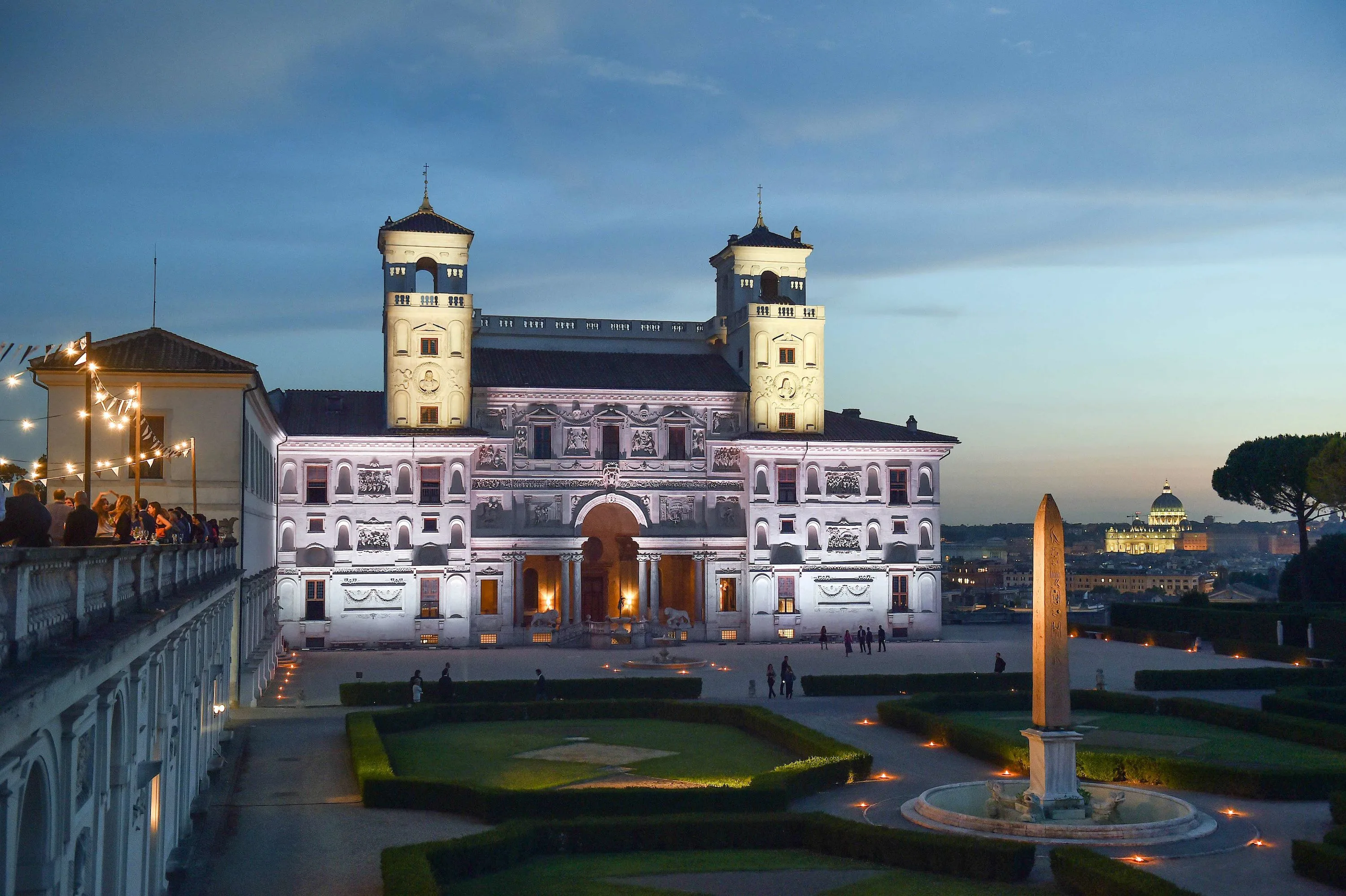
Medici Villa
 Highlight of Villa Borghese Gardens
Highlight of Villa Borghese GardensTake a peak at a 16th-century cardinal's villa that was once considered one of the grandest residences in the city.
Built-in 1564-74 and bought by Cardinal Ferdinando de'Medici in 1576, who further enlarged it, the Medici Villa was considered one of the grandest residences in the city. Galileo was held under house arrest here by the Inquisition in 1630-3. In 1801, the villa was bought by Napoleon and the French Academy was transferred here where it has remained to this day, meaning it is closed to the general public. French students who win the Prix de Rome are sent to study here for periods of six months to two years at the expense of the French government. Well-known scholars include Berlioz, Debussy, and Ingres. It remains one of the most important cultural institutions in Europe and the most beautiful villas to have preserved its garden in the center of Rome.

Galleria Borghese
 Highlight of Villa Borghese Gardens
Highlight of Villa Borghese GardensVisit Rome's most famous art gallery outside of the Vatican Museums.
The gallery started out as the private family collection of the powerful Borghese family, who poured much of their wealth into the patronage of the best Renaissance-era artists. It contains masterpieces not only by Bernini and Caravaggio, but also Raphael, Rubens, and Titian. Don't miss in particular Caravaggio's David with the Head of Goliath - the head is said to be a self-portrait. It's obligatory to book your visit in advance, you'll need a printable confirmation and a booking number.

National Gallery of Modern and Contemporary Art
 Highlight of Villa Borghese Gardens
Highlight of Villa Borghese GardensSee the most important collection in existence of Italian modern art.
The gallery was founded in 1883, although the current museum building was purpose-built for it in 1911. It displays paintings and sculptures of the nineteenth and twentieth centuries and is the largest such collection in Italy. In addition to Italian artists such as Giorgio de Chirico and Giorgio Morandi, you'll find works from non-Italian artists including Degas, Monet, and Jackson Pollock.

Medici Villa
 Highlight of Villa Borghese Gardens
Highlight of Villa Borghese GardensTake a peak at a 16th-century cardinal's villa that was once considered one of the grandest residences in the city.
Built-in 1564-74 and bought by Cardinal Ferdinando de'Medici in 1576, who further enlarged it, the Medici Villa was considered one of the grandest residences in the city. Galileo was held under house arrest here by the Inquisition in 1630-3. In 1801, the villa was bought by Napoleon and the French Academy was transferred here where it has remained to this day, meaning it is closed to the general public. French students who win the Prix de Rome are sent to study here for periods of six months to two years at the expense of the French government. Well-known scholars include Berlioz, Debussy, and Ingres. It remains one of the most important cultural institutions in Europe and the most beautiful villas to have preserved its garden in the center of Rome.

Galleria Borghese
 Highlight of Villa Borghese Gardens
Highlight of Villa Borghese GardensVisit Rome's most famous art gallery outside of the Vatican Museums.
The gallery started out as the private family collection of the powerful Borghese family, who poured much of their wealth into the patronage of the best Renaissance-era artists. It contains masterpieces not only by Bernini and Caravaggio, but also Raphael, Rubens, and Titian. Don't miss in particular Caravaggio's David with the Head of Goliath - the head is said to be a self-portrait. It's obligatory to book your visit in advance, you'll need a printable confirmation and a booking number.
prev
next

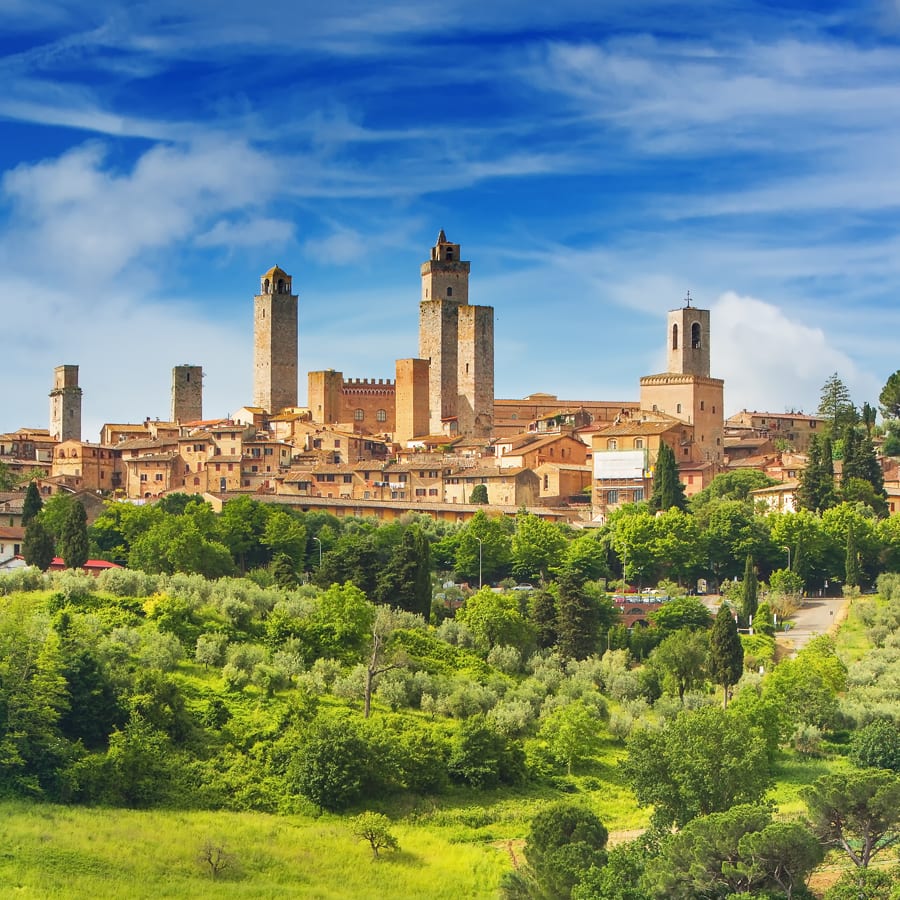
Day 7
Florence
View More
Day 7
Florence



9:00 AM - 3:00 PM
Half Day Excursion to San Gimignano and lunch stop at a local vineyard
Drive through the scenic Tuscan countryside to San Gimignano, one of the most charming and picturesque Tuscan hill towns with medieval towers built for the richest families of the time. You can choose to visit the Cathedral, climb the “Torre Grossa”, take pictures of the gorgeous landscape and enjoy a delicious gelato in the Cistern Square. After, you will be driven to a local Tuscan winery for lunch and some wine tasting. IMPORTANT NOTE : This excursion does not include a guide.

Day 7
Florence
View More


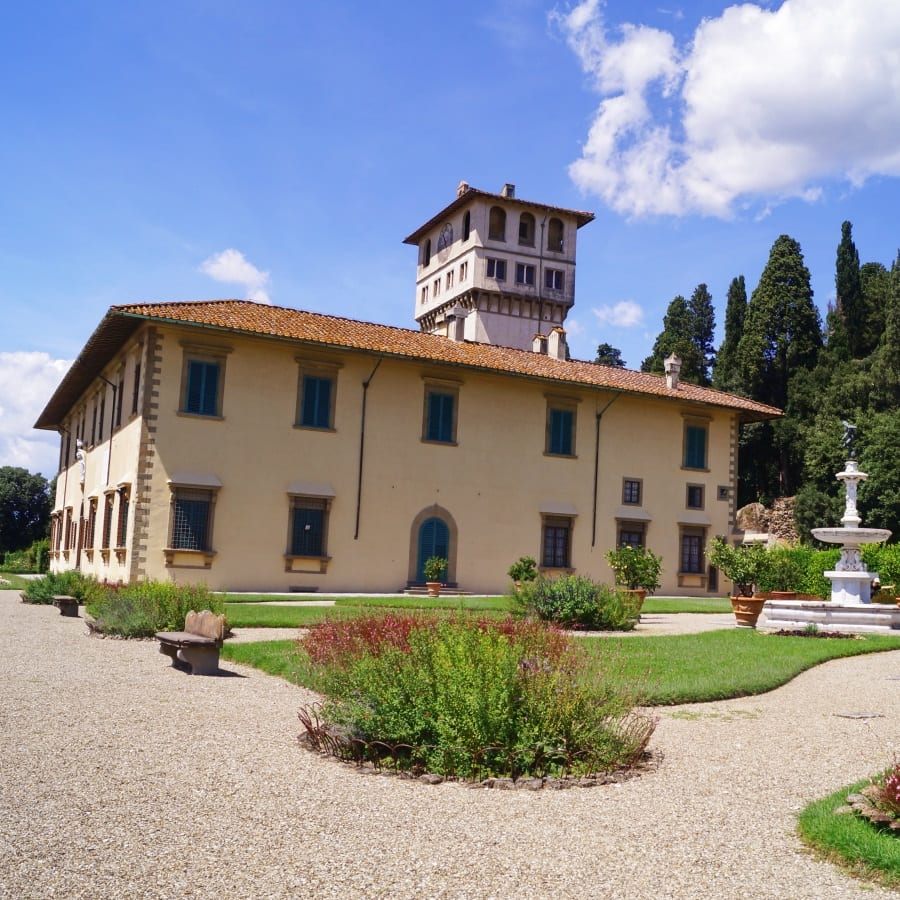
Day 8
Florence
View More
Day 8
Florence



Morning to Afternoon
Explore Renaissance Villas in the Nearby Hills of Florence
The Medicis and other powerful families of Renaissance Florence constructed magnificent country villas in the foothills surrounding the city and surrounded them with elaborate gardens populated with rose bushes, manicured hedgerows, and citrus trees. You can explore these beautiful villas which are concentrated in an area just a short bus ride from the city center of Florence. The villas served several functions, first and foremost as country palaces demonstrating power and wealth. They were also recreational resorts for the leisure and pleasure of their owners; and, more prosaically, they were the center of agricultural activities on the surrounding estates.

Villa di Castello
See the villa where Tuscany's first Grand Duke spent his childhood.
Show More

Villa La Petraia
Experience an amazing view of Florence as you stroll the gardens of this Medici family villa.
Show More

Villa di Castello
See the villa where Tuscany's first Grand Duke spent his childhood.
Show More

Villa La Petraia
Experience an amazing view of Florence as you stroll the gardens of this Medici family villa.
Show More

Villa di Castello
See the villa where Tuscany's first Grand Duke spent his childhood.
Show More

Villa La Petraia
Experience an amazing view of Florence as you stroll the gardens of this Medici family villa.
Show More
prev
next

Day 8
Florence
View More


Villa di Castello
 Highlight of Country Villas
Highlight of Country VillasSee the villa where Tuscany's first Grand Duke spent his childhood.
Villa di Castello is a 15th century Medici villa mostly famous as the residence where Duke Cosimo I de’Medici spent his childhood. Cosimo, who was later called the Father of the Nation, was the first member of the Medici political dynasty. Not surprisingly, Villa di Castello was his favourite villa and as an adult he expanded it with an extensive garden second only to the Boboli Gardens that included footpaths, fountains and the world famous Animal Grotto. The Villa is not accessible to the public since it has been the home of the prestigious Crusca Academy since 1583, a school dedicated to the study of the Italian language. You can, however, visit the splendid gardens without paying.

Villa La Petraia
 Highlight of Country Villas
Highlight of Country VillasExperience an amazing view of Florence as you stroll the gardens of this Medici family villa.
This fortified hilltop mansion was purchased by the Medici in the 16th century and transformed into a princely residence by Cardinal Ferdinando. The villa is richly decorated in the interior and has a beautiful Italian garden that attracts visitors from all around the world. The courtyard that is decorated with frescoes by Cosimo Daddi is probably the most impressive part of the villa, while a series of rooms you can visit present a later style. Both the structured Italian garden and the villa are open to visitors and the admission is free, with guided visits.

Villa di Castello
 Highlight of Country Villas
Highlight of Country VillasSee the villa where Tuscany's first Grand Duke spent his childhood.
Villa di Castello is a 15th century Medici villa mostly famous as the residence where Duke Cosimo I de’Medici spent his childhood. Cosimo, who was later called the Father of the Nation, was the first member of the Medici political dynasty. Not surprisingly, Villa di Castello was his favourite villa and as an adult he expanded it with an extensive garden second only to the Boboli Gardens that included footpaths, fountains and the world famous Animal Grotto. The Villa is not accessible to the public since it has been the home of the prestigious Crusca Academy since 1583, a school dedicated to the study of the Italian language. You can, however, visit the splendid gardens without paying.

Villa La Petraia
 Highlight of Country Villas
Highlight of Country VillasExperience an amazing view of Florence as you stroll the gardens of this Medici family villa.
This fortified hilltop mansion was purchased by the Medici in the 16th century and transformed into a princely residence by Cardinal Ferdinando. The villa is richly decorated in the interior and has a beautiful Italian garden that attracts visitors from all around the world. The courtyard that is decorated with frescoes by Cosimo Daddi is probably the most impressive part of the villa, while a series of rooms you can visit present a later style. Both the structured Italian garden and the villa are open to visitors and the admission is free, with guided visits.

Villa di Castello
 Highlight of Country Villas
Highlight of Country VillasSee the villa where Tuscany's first Grand Duke spent his childhood.
Villa di Castello is a 15th century Medici villa mostly famous as the residence where Duke Cosimo I de’Medici spent his childhood. Cosimo, who was later called the Father of the Nation, was the first member of the Medici political dynasty. Not surprisingly, Villa di Castello was his favourite villa and as an adult he expanded it with an extensive garden second only to the Boboli Gardens that included footpaths, fountains and the world famous Animal Grotto. The Villa is not accessible to the public since it has been the home of the prestigious Crusca Academy since 1583, a school dedicated to the study of the Italian language. You can, however, visit the splendid gardens without paying.

Villa La Petraia
 Highlight of Country Villas
Highlight of Country VillasExperience an amazing view of Florence as you stroll the gardens of this Medici family villa.
This fortified hilltop mansion was purchased by the Medici in the 16th century and transformed into a princely residence by Cardinal Ferdinando. The villa is richly decorated in the interior and has a beautiful Italian garden that attracts visitors from all around the world. The courtyard that is decorated with frescoes by Cosimo Daddi is probably the most impressive part of the villa, while a series of rooms you can visit present a later style. Both the structured Italian garden and the villa are open to visitors and the admission is free, with guided visits.
prev
next

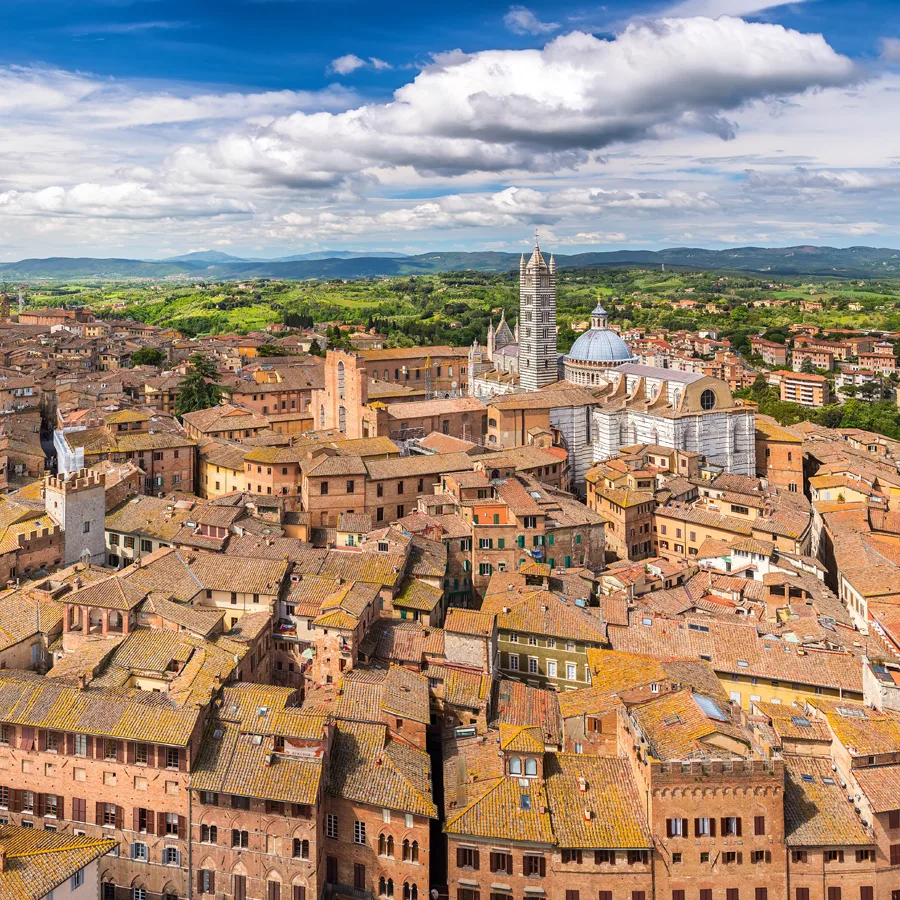
Day 9
Florence
View More
Day 9
Florence

Early Morning to Early Evening
Excursion to the Medieval Hilltop Town of Siena
For beauty and interest in Tuscany, only Siena comes close to Florence. Only an hour-and-a-half from Florence by train, it makes for a perfect day trip. The mesmerising brick-built medieval town with its narrow streets winding down into the valleys below was once a great regional power which rivaled Florence, and famously defeated the larger town in the legendary Battle of Montaperti. Its main square, the Campo, is one of the most satisfying urban spaces ever built, playing host to the annual Palio horse race in which each of the town's 17 contrade (i.e. city districts) participate. The traffic-free streets have been wonderfully preserved and its great Gothic buildings still exhibit the artistic masterpieces of the Sienese school of painting commissioned for them during the town's heyday in the 14th century.

Pinacoteca Nazionale
Make time to visit this gallery holding precious art and history from the Gothic era, when Siena's power and influence peaked.
Show More

Duomo di Siena
Experience a riot of the senses as you walk into one of Tuscany's most colorful and remarkable cathedrals.
Show More

Piazza del Campo
Stop and linger in one of the more glorious and satisfying urban spaces ever built.
Show More

Palazzo Pubblico and Museo Civico
Make your way into the courtyard of this brick palace built in the 13th century and enter the Museo Civico, where you will marvel at the beautiful murals which adorn the interiors.
Show More

Pinacoteca Nazionale
Make time to visit this gallery holding precious art and history from the Gothic era, when Siena's power and influence peaked.
Show More

Duomo di Siena
Experience a riot of the senses as you walk into one of Tuscany's most colorful and remarkable cathedrals.
Show More

Piazza del Campo
Stop and linger in one of the more glorious and satisfying urban spaces ever built.
Show More

Palazzo Pubblico and Museo Civico
Make your way into the courtyard of this brick palace built in the 13th century and enter the Museo Civico, where you will marvel at the beautiful murals which adorn the interiors.
Show More
prev
next

Day 9
Florence
View More

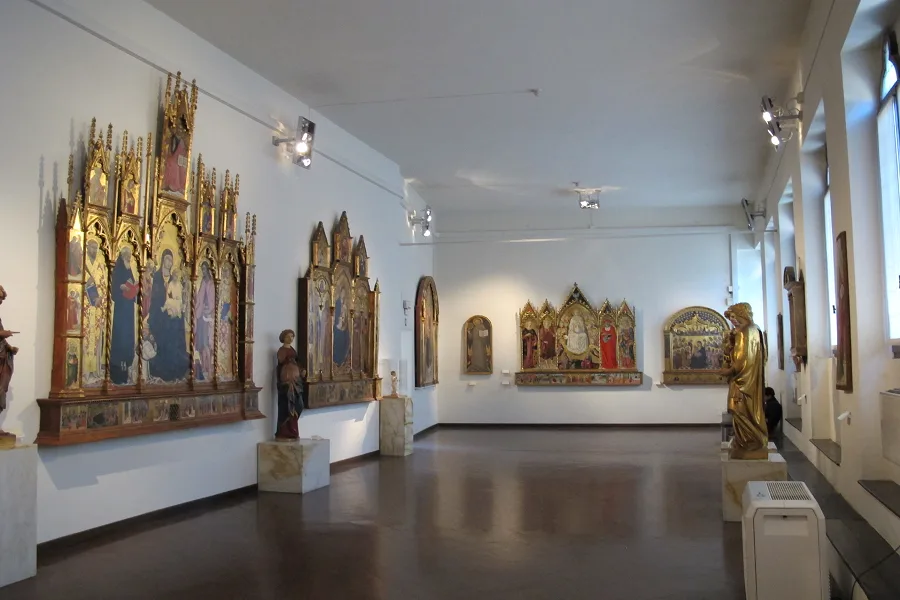
Pinacoteca Nazionale
 Highlight of Siena Excursion
Highlight of Siena ExcursionMake time to visit this gallery holding precious art and history from the Gothic era, when Siena's power and influence peaked.
This is the main state art museum of the city and includes a rich collection of masterpieces from the famous Sienese school of artists, which created mainly large, majestic altarpieces with golden decorations. The "gold" background paintings include a piece by Master of Tressa which marks the beginning of the golden age of Sienese painting.
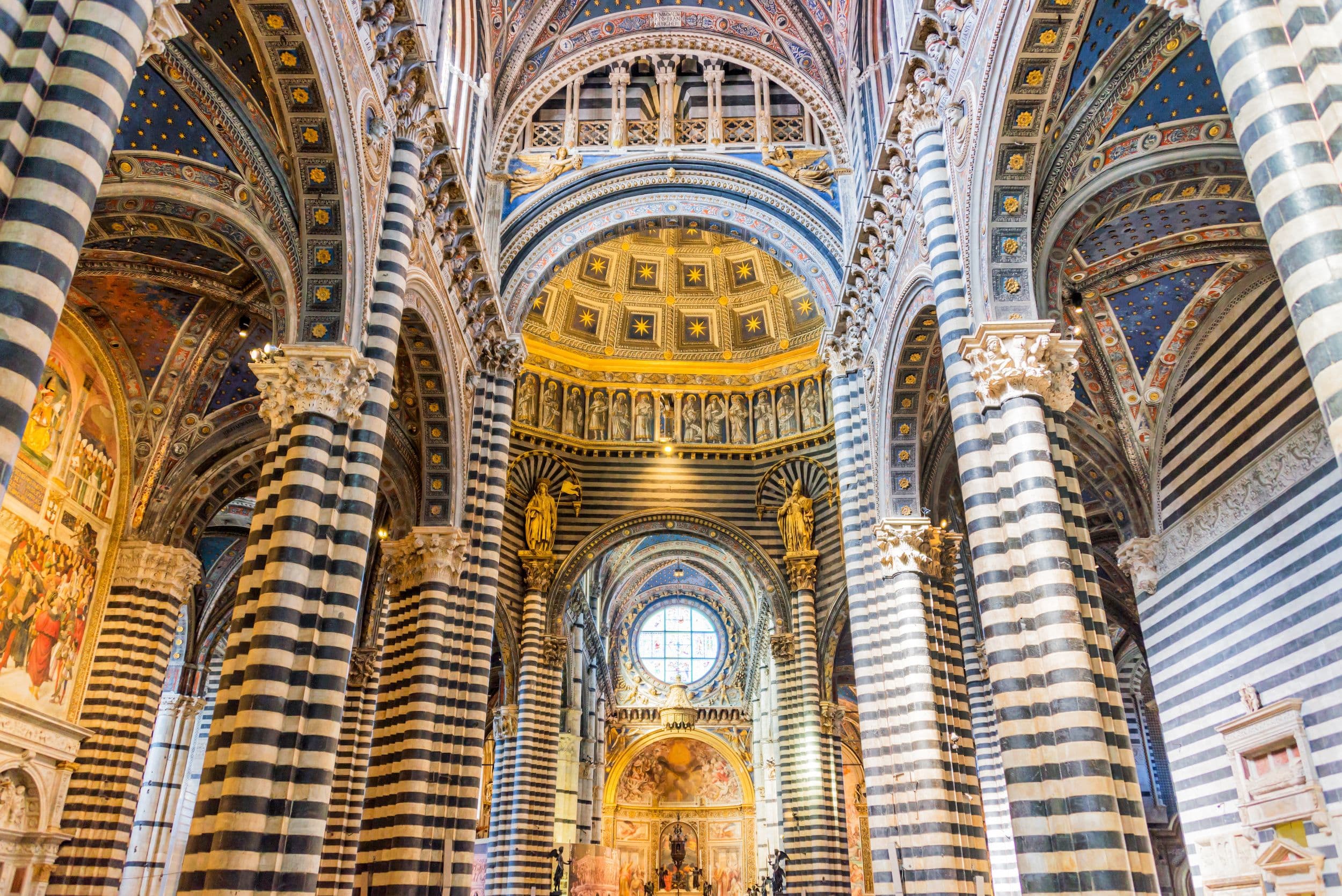
Duomo di Siena
 Highlight of Siena Excursion
Highlight of Siena ExcursionExperience a riot of the senses as you walk into one of Tuscany's most colorful and remarkable cathedrals.
Siena's Duomo is a fabulous conglomeration of Romanesque and Gothic architecture, delineated by encircling bands of black and white marble. It is the earliest of all the great Tuscan cathedrals, having been mostly completed by 1263. Before you enter, take a moment to admire the marble facade and its remarkable statuary. Once inside, you can invest in the audio guide to get the most out of a visit. The standout artistic treasure is the pulpit with columns resting on the backs of alternating lions and lionesses. The Piccolomini Library was added on to the cathedral in 1495 by the future Pope Pius III, and is one of the loveliest rooms in all Italy thanks to its cycle of crystal-sharp, brilliantly colorful frescoes.

Piazza del Campo
 Highlight of Siena Excursion
Highlight of Siena ExcursionStop and linger in one of the more glorious and satisfying urban spaces ever built.
With its remarkable fan shape and gentle slope, the Piazza del Campo is one of the more memorable and unique public squares in Europe. It has been heart of Siena since the mid-12th century when it was built on the site of a Roman marketplace. Cafes line the square offering coffee and aperitivo for the young and old alike who relax and take in the scene. The piazza is made doubly famous by the fact that it hosts the annual Palio horse race, a hotly-contested event which splits the city into competing factions.
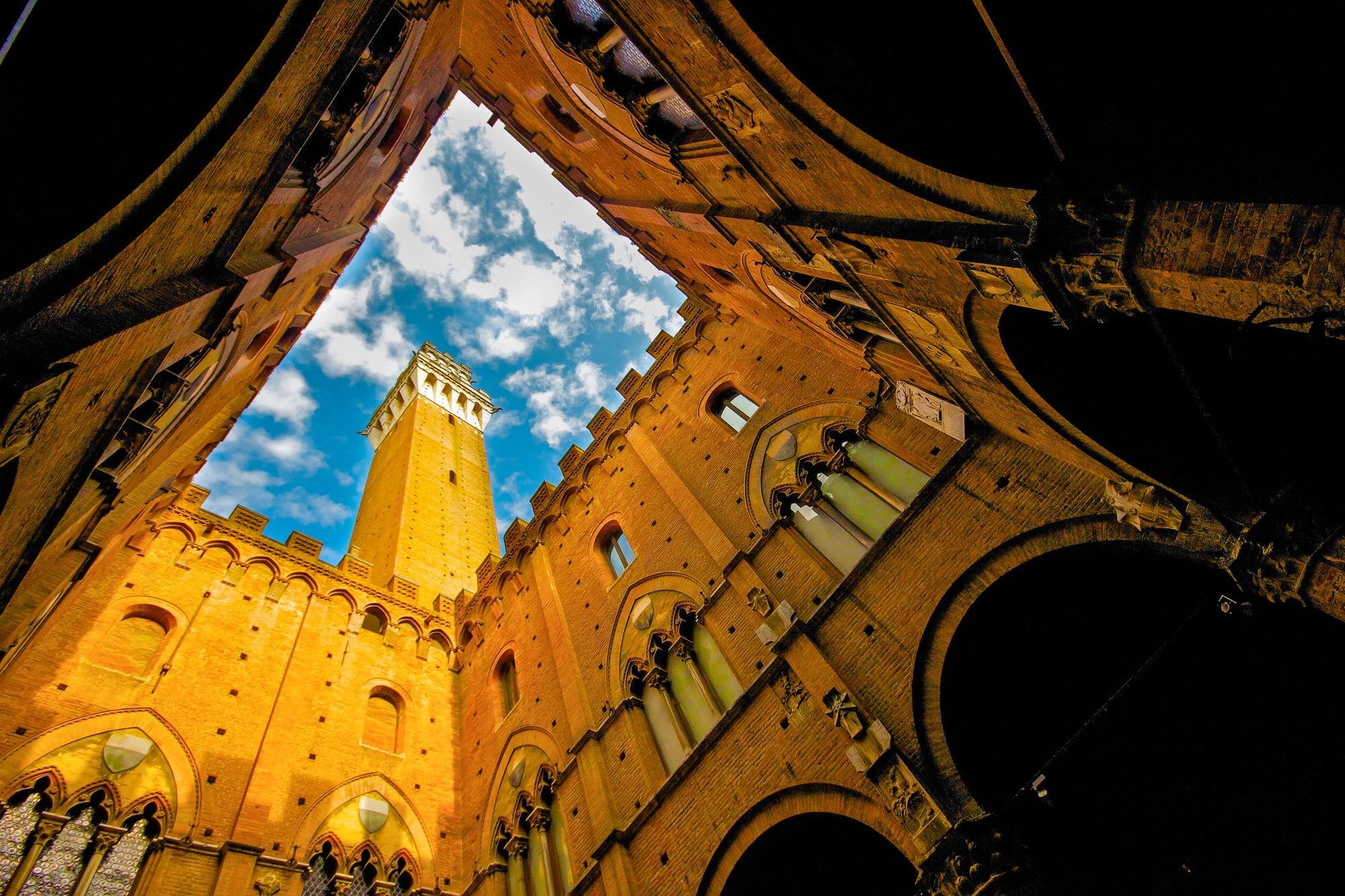
Palazzo Pubblico and Museo Civico
 Highlight of Siena Excursion
Highlight of Siena ExcursionMake your way into the courtyard of this brick palace built in the 13th century and enter the Museo Civico, where you will marvel at the beautiful murals which adorn the interiors.
Dominating the Piazza del Campo, this 13th century palace and tower was built as a symbol of the independence and wealth of Siena by the Government of Nine (Governo dei Nove) - nine representatives of the people elected by the merchant class, not noble families. Looking at its façade from the Piazza del Campo, it's possible to immediately see its different periods of construction: on the lower level of the three-mullioned (triple-arched) windows the stone that was used and then later brick. The 400 steps to the top of the palace tower is no easy feat even for the fittest of travelers, but the view over the city and Piazza del Campo below make the narrow ascent worth it. Inside the palace courtyard you will find the entrance to the Museo Civico, a treasure trove of magnificent works of art which can be seen inside the palace. One of the most beautiful rooms in the palace is the Sala dei Nove, the Hall of the Nine, with the Allegories of Good and Bad Government by Ambrogio Lorenzetti where you can see the medieval city with its workshops and artisans.

Pinacoteca Nazionale
 Highlight of Siena Excursion
Highlight of Siena ExcursionMake time to visit this gallery holding precious art and history from the Gothic era, when Siena's power and influence peaked.
This is the main state art museum of the city and includes a rich collection of masterpieces from the famous Sienese school of artists, which created mainly large, majestic altarpieces with golden decorations. The "gold" background paintings include a piece by Master of Tressa which marks the beginning of the golden age of Sienese painting.

Duomo di Siena
 Highlight of Siena Excursion
Highlight of Siena ExcursionExperience a riot of the senses as you walk into one of Tuscany's most colorful and remarkable cathedrals.
Siena's Duomo is a fabulous conglomeration of Romanesque and Gothic architecture, delineated by encircling bands of black and white marble. It is the earliest of all the great Tuscan cathedrals, having been mostly completed by 1263. Before you enter, take a moment to admire the marble facade and its remarkable statuary. Once inside, you can invest in the audio guide to get the most out of a visit. The standout artistic treasure is the pulpit with columns resting on the backs of alternating lions and lionesses. The Piccolomini Library was added on to the cathedral in 1495 by the future Pope Pius III, and is one of the loveliest rooms in all Italy thanks to its cycle of crystal-sharp, brilliantly colorful frescoes.

Piazza del Campo
 Highlight of Siena Excursion
Highlight of Siena ExcursionStop and linger in one of the more glorious and satisfying urban spaces ever built.
With its remarkable fan shape and gentle slope, the Piazza del Campo is one of the more memorable and unique public squares in Europe. It has been heart of Siena since the mid-12th century when it was built on the site of a Roman marketplace. Cafes line the square offering coffee and aperitivo for the young and old alike who relax and take in the scene. The piazza is made doubly famous by the fact that it hosts the annual Palio horse race, a hotly-contested event which splits the city into competing factions.

Palazzo Pubblico and Museo Civico
 Highlight of Siena Excursion
Highlight of Siena ExcursionMake your way into the courtyard of this brick palace built in the 13th century and enter the Museo Civico, where you will marvel at the beautiful murals which adorn the interiors.
Dominating the Piazza del Campo, this 13th century palace and tower was built as a symbol of the independence and wealth of Siena by the Government of Nine (Governo dei Nove) - nine representatives of the people elected by the merchant class, not noble families. Looking at its façade from the Piazza del Campo, it's possible to immediately see its different periods of construction: on the lower level of the three-mullioned (triple-arched) windows the stone that was used and then later brick. The 400 steps to the top of the palace tower is no easy feat even for the fittest of travelers, but the view over the city and Piazza del Campo below make the narrow ascent worth it. Inside the palace courtyard you will find the entrance to the Museo Civico, a treasure trove of magnificent works of art which can be seen inside the palace. One of the most beautiful rooms in the palace is the Sala dei Nove, the Hall of the Nine, with the Allegories of Good and Bad Government by Ambrogio Lorenzetti where you can see the medieval city with its workshops and artisans.
prev
next


Day 10
Depart Florence
View More
Day 10
Depart Florence

To Be Determined
Private Transfer from Hotel to Florence Airport
A private transfer service will pick you up from the N/A and take you directly to Florence Airport. This is a private transfer for you and your travel party. You do not need to pay the driver as the cost of the transfer is included in your itinerary. IMPORTANT NOTE: Please be aware the car service can fit up to 1 checked item of luggage and 1 personal item per person, such as a purse or small backpack. If you think you will have more baggage, please inform your travel consultant as this may result in an additional fee.

Day 10
Depart Florence
View More


What's Included In Your Trip

Pre-Paid Tours and Activities:
- Heart of the Empire - Private Tour of Ancient Rome & the Colosseum
- Half Day Excursion to San Gimignano and lunch stop at a local vineyard
- City Card for Rome, including discounts to many popular attractions

Pre-Paid Transportation:
- 2nd Class Train Tickets from Rome-Florence
- Public Transport Tickets for Rome
- Private Transfer from Rome Fiumicino to Hotel
- Private Transfer to Rome Termini Train Station
- Private Transfer from Hotel to Florence Airport

Accommodation:
- 6 nights at a hotel of your choice in Rome
- 5 nights at a hotel of your choice in Florence

Go Real Travel Mobile App:
- Itinerary Plan & Reservations Info
- Points of Interest
- Detailed Travel Information
- Maps & Directions
Other Trips You May Like

12 Days
From$3129USD

10 Days
From$2749USD

10 Days
From$2600USD

12 Days
From$3175USD

10 Days
From$2645USD
Paris, Rome, Florence: An Unforgettable 10-Day Itinerary to Europe's Most Iconic Destinations

Italy, France

7 Days
From$2139USD

14 Days
From$3559USD

10 Days
From$4033USD

8 Days
From$2424USD

12 Days
From$3129USD

10 Days
From$2749USD

10 Days
From$2600USD

12 Days
From$3175USD

10 Days
From$2645USD
Paris, Rome, Florence: An Unforgettable 10-Day Itinerary to Europe's Most Iconic Destinations

Italy, France

7 Days
From$2139USD

14 Days
From$3559USD

10 Days
From$4033USD

8 Days
From$2424USD
prev
next
Featured Blogs
prev
next
Our Customers Say It Best
Otto Chuy, Los Angeles, California
I am still surprised how everything worked as planned, without a hitch. All instructions in your itinerary were precise and correct. Your suggestions and comments in each of the locations we went to were very helpful. All your guides, without exception, were wonderful and exactly on time. 

Kathy Mongeau, Ottawa, Ontario
My sister, Ann Ibberson, and I have been back home for a few weeks now and still go on and on about our fabulous trip. We were just blown away in every respect. Given the fact that we only had 1 ½ weeks, you had everything arranged for us so efficiently and your contacts who we dealt with for transfers, tours, hotels were extremely professional and personable. Things could not have gone better. 

Clive Andrew, Brisbane, Queensland
Just a quick note to let you know that I am back home now after probably the best overseas holiday that I have ever had, in no small part due to your very capable organization booking of hotels, tours, & trains. There was just nothing that went wrong with the timings etc. 

Malini Dutta, Boston, Massachusetts
We can't thank you enough for the detailed plans, maps, and suggestions. It really felt that someone was holding our hands and showing us around. We had all the excitement of discovering foreign lands, with none of the problems that can happen while negotiating unfamiliar places. In fact, all the cities felt like home within a few hours of arriving and exploring. 

Bev and Mark Frankel, Williamsburg, Virginia
We could not be more pleased with Go Real Travel! You took the guess work out of things like public transport but still managed to allow us the freedom to tour as we wanted. Our guides were exceptional and every time I saw a Viking Cruise tour of 25 people, I realized the quality experience we were getting with Go Real. 

Marianne Strydom, Paarl, South Africa
I just wanted to thank you for organizing an amazing trip for me – I packed in so much in such a short period of time and everything was just perfect. The way you do things makes it possible to really get to know the destination, which for me as a travel agent could not have been better. 

Otto Chuy, Los Angeles, California
I am still surprised how everything worked as planned, without a hitch. All instructions in your itinerary were precise and correct. Your suggestions and comments in each of the locations we went to were very helpful. All your guides, without exception, were wonderful and exactly on time. 

Kathy Mongeau, Ottawa, Ontario
My sister, Ann Ibberson, and I have been back home for a few weeks now and still go on and on about our fabulous trip. We were just blown away in every respect. Given the fact that we only had 1 ½ weeks, you had everything arranged for us so efficiently and your contacts who we dealt with for transfers, tours, hotels were extremely professional and personable. Things could not have gone better. 

Clive Andrew, Brisbane, Queensland
Just a quick note to let you know that I am back home now after probably the best overseas holiday that I have ever had, in no small part due to your very capable organization booking of hotels, tours, & trains. There was just nothing that went wrong with the timings etc. 

Malini Dutta, Boston, Massachusetts
We can't thank you enough for the detailed plans, maps, and suggestions. It really felt that someone was holding our hands and showing us around. We had all the excitement of discovering foreign lands, with none of the problems that can happen while negotiating unfamiliar places. In fact, all the cities felt like home within a few hours of arriving and exploring. 

Bev and Mark Frankel, Williamsburg, Virginia
We could not be more pleased with Go Real Travel! You took the guess work out of things like public transport but still managed to allow us the freedom to tour as we wanted. Our guides were exceptional and every time I saw a Viking Cruise tour of 25 people, I realized the quality experience we were getting with Go Real. 

Marianne Strydom, Paarl, South Africa
I just wanted to thank you for organizing an amazing trip for me – I packed in so much in such a short period of time and everything was just perfect. The way you do things makes it possible to really get to know the destination, which for me as a travel agent could not have been better. 



Explore cities in more detail

Milan
Milan is Italy’s most forward-looking city. An international center for fashion, fine dining, and design, it seems as though Milanese people breathe style. From the gleam on your wine glass to the twists of its cathedral’s spires, everything in Milan is finished to perfection. Home to the Italian stock exchange, a world-famous fashion industry, and a frantic business district, Milan is fast-paced and commercially minded. The shopping in Milan is second to none. At the Galleria Vittorio Emanuele II, one of the world’s oldest shopping malls, a glass-iron ceiling soars over brands like Louis Vuitton, Gucci, Massimo Dutti, and Amani. Along with the fashion, Milan’s cathedral, castle, and canals are also must-sees. But to view the city’s most prized possession - Leonardo da Vinci’s Last Supper, you must make an appointment. Tickets to view this mural sell out weeks in advance. It is truly a bucket-list worthy work of art. After a day taking in all the glamor and culture, take a seat in one of Milan’s well-appointed eateries. The Navigli Quarter is packed with restaurants, bars, and cafes, perfect for a relaxed Aperol spritz or pizza along the city’s canals.
Read More
Learn About Milan
Build Milan Trip

Cinque Terre
Cinque Terre, a string of five fishing villages in the Liguria region of Italy, is a rare snapshot of a traditional way of life. Rustic and charming, these clusters of pastel houses clinging to steep Mediterranean cliffs hold a special allure. Hiking between the five villages is a popular way to experience the rugged Mediterranean landscape close up. There are no roads here — the only other way to get between the villages is by boat or train. Seafood, hauled in from the azure waters of the sea that laps against the rocky shore, is abundant and delicious here. It pairs well with the local wine, and perhaps a plate of olives. Cinque Terre is a place to take it slow, to breathe in the fresh sea air and bask in the balmy climate, many miles from the chaos and frenzy of the modern world.
Read More
Learn About Cinque Terre
Build Cinque Terre Trip
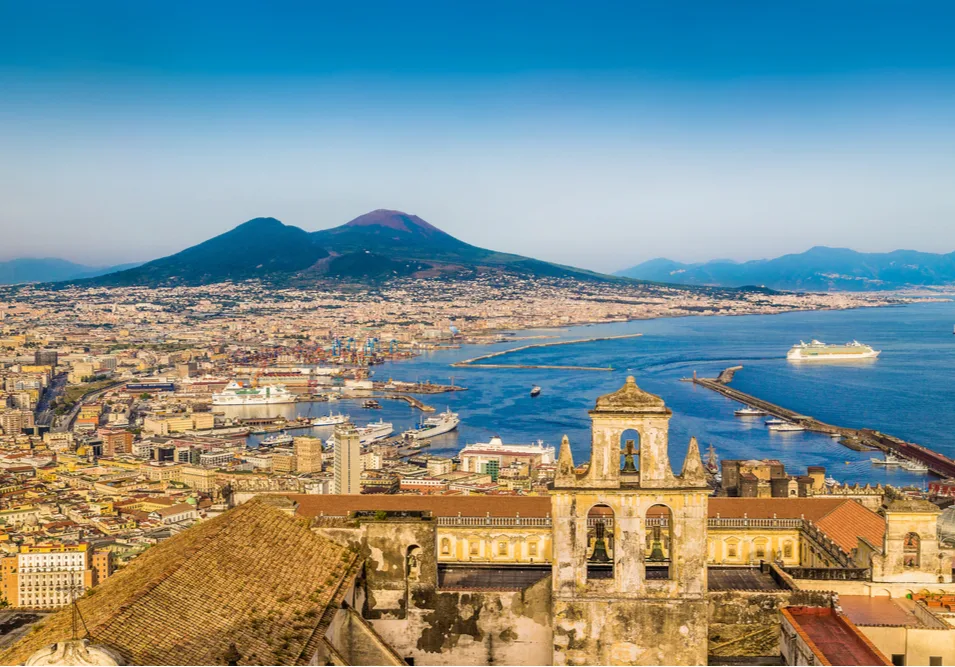
Naples
Gritty and chaotic Naples calls to travelers who want to experience the real Italy. Pressed along the coast of Campania, hilly Naples is jammed with maze-like streets, strung with outdoor clotheslines, descending toward the sea below. A much deserved UNESCO World Heritage site, Naples is famous for its churches, museums, castles, and catacombs. As you navigate the city, you’ll find yourself immersed by its culture and history. You can easily occupy a full day gazing at churches like the Naples Cathedral, San Francesco di Paola, and Cappella Sansevero. If you cast your eyes toward the Gulf of Naples, you’ll see Mount Vesuvius looming over the harbor. This foreboding volcano erupted in AD 79. Not far from the inner city — less than an hour by train — you’ll find the ancient town of Pompeii, its dramatic ruins still preserved in ash from the eruption. One of the best things you can do in Naples is to eat. This is the city where pizza was born. Propped up by its ripe tomatoes, local cheeses, and fresh fish, food from Naples has come to define what many see as the height of Italian cuisine. Everything you taste in Naples seems like a delicacy. Authentic and vivid, Naples is a true Italian city where the ancient world meets the modern-day with a bang.
Read More
Learn About Naples
Build Naples Trip

Rome
One of the must-sees of Italy, and indeed all of Europe, Rome is a city with history flowing through its veins. There is an endless amount to see, do, and learn here, with something for every taste and disposition. Rome was the center of Western civilization for a Millenium and during that time, accumulated a list of historical and cultural treasures that no other destination can truly match. The Pantheon, Colosseum, Roman Forum, and Cirus of Maxentius are just a few examples of what can be seen and experienced in Rome, which at times feels more like a giant outdoor museum than a city. At Rome’s heart, you’ll find the Vatican, home of the Roman Catholic Church and the Pope. Here visitors can see the legendary Sistine Chapel. Transcending a mere building, the chapel is a walk-in work of art. Although historical sights can be found on just about every corner, it’s entirely possible to fill a day just wandering around Rome. The city’s charming streets and open Piazzas are filled with beautiful sights and places to sit, grab the best Cappuccino in the world, and enjoy the view.
Read More
Learn About Rome
Build Rome Trip

Florence
Culture and history are thick in the air in Florence. Located on the banks of the Arno River in Tuscany, Florence’s past is deeply compelling. The birthplace of the Renaissance, Florence is where innovators like Dante, Machiavelli, Michelangelo, and Da Vinci made their fortunes. Centuries of art, politics, and commerce have left their mark on every stone in this Northern Italian city. In the 15th and 16th centuries, Florentine banks funded new enterprises that went on to change the history of the world. Powerful families like the Medici’s financed some of the finest art in history and pioneered new ways of doing statecraft and politics. As you stand in the Piazzale Michelangelo and gaze upon the city below it’s hard to take it all in at once. It feels like behind every door in Florence might hide a work of genius. Michelangelo’s David and Botticelli’s Primavera can be found just a short walk away. After a long day wandering the streets and gazing at art, fueled by exquisite coffee and gelato, relax like the locals do: with a glass of some of the best wine in the world.
Read More
Learn About Florence
Build Florence Trip
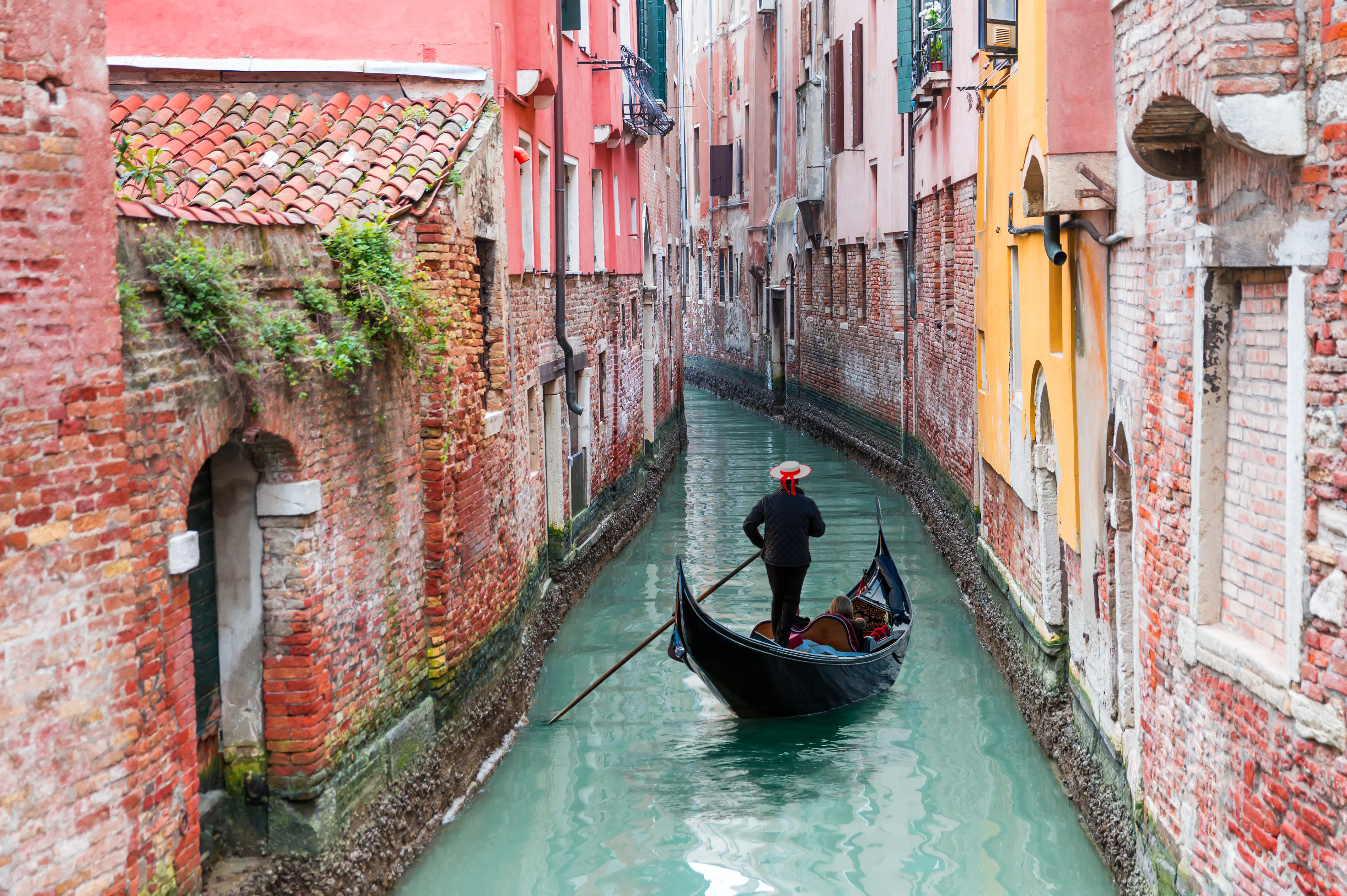
Venice
Venice is a city with no equal. Built on a series of islands on a lagoon, it was once a powerful city-state. Echoes of that old magnificence can be seen everywhere here, from the stunning buildings that rise out of the canals, to the bridges that arc across them. Take a Gondola ride through the canals that form the city’s veins, or wander through the winding streets drinking in the sights. You’ll see Venice attracts tourists in huge numbers, and that’s with good reason. It’s home to a seemingly limitless amount of art, culture, history, and architecture. St Mark’s Basilica, the Doge’s Palace, and the Campanile di San Marco just barely scratch the surface. There’s a 700-year-old market, Rialto, which is still open today. The Ponte di Rialto bridge connects the neighborhoods of San Marco and San Polo, stretching across the Grand Canal. Venice has weathered the last several centuries with elegance and pride, a place that will surpass even your highest expectations.
Read More
Learn About Venice
Build Venice Trip

Milan
Milan is Italy’s most forward-looking city. An international center for fashion, fine dining, and design, it seems as though Milanese people breathe style. From the gleam on your wine glass to the twists of its cathedral’s spires, everything in Milan is finished to perfection. Home to the Italian stock exchange, a world-famous fashion industry, and a frantic business district, Milan is fast-paced and commercially minded. The shopping in Milan is second to none. At the Galleria Vittorio Emanuele II, one of the world’s oldest shopping malls, a glass-iron ceiling soars over brands like Louis Vuitton, Gucci, Massimo Dutti, and Amani. Along with the fashion, Milan’s cathedral, castle, and canals are also must-sees. But to view the city’s most prized possession - Leonardo da Vinci’s Last Supper, you must make an appointment. Tickets to view this mural sell out weeks in advance. It is truly a bucket-list worthy work of art. After a day taking in all the glamor and culture, take a seat in one of Milan’s well-appointed eateries. The Navigli Quarter is packed with restaurants, bars, and cafes, perfect for a relaxed Aperol spritz or pizza along the city’s canals.
Read More
Learn About Milan
Build Milan Trip

Cinque Terre
Cinque Terre, a string of five fishing villages in the Liguria region of Italy, is a rare snapshot of a traditional way of life. Rustic and charming, these clusters of pastel houses clinging to steep Mediterranean cliffs hold a special allure. Hiking between the five villages is a popular way to experience the rugged Mediterranean landscape close up. There are no roads here — the only other way to get between the villages is by boat or train. Seafood, hauled in from the azure waters of the sea that laps against the rocky shore, is abundant and delicious here. It pairs well with the local wine, and perhaps a plate of olives. Cinque Terre is a place to take it slow, to breathe in the fresh sea air and bask in the balmy climate, many miles from the chaos and frenzy of the modern world.
Read More
Learn About Cinque Terre
Build Cinque Terre Trip

Naples
Gritty and chaotic Naples calls to travelers who want to experience the real Italy. Pressed along the coast of Campania, hilly Naples is jammed with maze-like streets, strung with outdoor clotheslines, descending toward the sea below. A much deserved UNESCO World Heritage site, Naples is famous for its churches, museums, castles, and catacombs. As you navigate the city, you’ll find yourself immersed by its culture and history. You can easily occupy a full day gazing at churches like the Naples Cathedral, San Francesco di Paola, and Cappella Sansevero. If you cast your eyes toward the Gulf of Naples, you’ll see Mount Vesuvius looming over the harbor. This foreboding volcano erupted in AD 79. Not far from the inner city — less than an hour by train — you’ll find the ancient town of Pompeii, its dramatic ruins still preserved in ash from the eruption. One of the best things you can do in Naples is to eat. This is the city where pizza was born. Propped up by its ripe tomatoes, local cheeses, and fresh fish, food from Naples has come to define what many see as the height of Italian cuisine. Everything you taste in Naples seems like a delicacy. Authentic and vivid, Naples is a true Italian city where the ancient world meets the modern-day with a bang.
Read More
Learn About Naples
Build Naples Trip

Rome
One of the must-sees of Italy, and indeed all of Europe, Rome is a city with history flowing through its veins. There is an endless amount to see, do, and learn here, with something for every taste and disposition. Rome was the center of Western civilization for a Millenium and during that time, accumulated a list of historical and cultural treasures that no other destination can truly match. The Pantheon, Colosseum, Roman Forum, and Cirus of Maxentius are just a few examples of what can be seen and experienced in Rome, which at times feels more like a giant outdoor museum than a city. At Rome’s heart, you’ll find the Vatican, home of the Roman Catholic Church and the Pope. Here visitors can see the legendary Sistine Chapel. Transcending a mere building, the chapel is a walk-in work of art. Although historical sights can be found on just about every corner, it’s entirely possible to fill a day just wandering around Rome. The city’s charming streets and open Piazzas are filled with beautiful sights and places to sit, grab the best Cappuccino in the world, and enjoy the view.
Read More
Learn About Rome
Build Rome Trip

Florence
Culture and history are thick in the air in Florence. Located on the banks of the Arno River in Tuscany, Florence’s past is deeply compelling. The birthplace of the Renaissance, Florence is where innovators like Dante, Machiavelli, Michelangelo, and Da Vinci made their fortunes. Centuries of art, politics, and commerce have left their mark on every stone in this Northern Italian city. In the 15th and 16th centuries, Florentine banks funded new enterprises that went on to change the history of the world. Powerful families like the Medici’s financed some of the finest art in history and pioneered new ways of doing statecraft and politics. As you stand in the Piazzale Michelangelo and gaze upon the city below it’s hard to take it all in at once. It feels like behind every door in Florence might hide a work of genius. Michelangelo’s David and Botticelli’s Primavera can be found just a short walk away. After a long day wandering the streets and gazing at art, fueled by exquisite coffee and gelato, relax like the locals do: with a glass of some of the best wine in the world.
Read More
Learn About Florence
Build Florence Trip

Venice
Venice is a city with no equal. Built on a series of islands on a lagoon, it was once a powerful city-state. Echoes of that old magnificence can be seen everywhere here, from the stunning buildings that rise out of the canals, to the bridges that arc across them. Take a Gondola ride through the canals that form the city’s veins, or wander through the winding streets drinking in the sights. You’ll see Venice attracts tourists in huge numbers, and that’s with good reason. It’s home to a seemingly limitless amount of art, culture, history, and architecture. St Mark’s Basilica, the Doge’s Palace, and the Campanile di San Marco just barely scratch the surface. There’s a 700-year-old market, Rialto, which is still open today. The Ponte di Rialto bridge connects the neighborhoods of San Marco and San Polo, stretching across the Grand Canal. Venice has weathered the last several centuries with elegance and pride, a place that will surpass even your highest expectations.
Read More
Learn About Venice
Build Venice Trip
prev
next


 Map of Your Itinerary Route
Map of Your Itinerary Route
Zoom In to the cities to see your itinerary in more detail


 4.8
4.8 







